Password Manager For WHMCS
(→About Password Manager For WHMCS) |
|||
| Line 6: | Line 6: | ||
|style="padding: 10px 0px 10px 0px;"|'''Password Manager For WHMCS''' gives you the possibility to store passwords and share them safely with your staff and clients.<br /> | |style="padding: 10px 0px 10px 0px;"|'''Password Manager For WHMCS''' gives you the possibility to store passwords and share them safely with your staff and clients.<br /> | ||
The module offers various mechanisms allowing you to conveniently manage passwords, send email reminders, as well as integrate with your WHMCS client area.<br /> | The module offers various mechanisms allowing you to conveniently manage passwords, send email reminders, as well as integrate with your WHMCS client area.<br /> | ||
| − | Owing to implementation of advanced two way encryption, Password Manager For WHMCS provides a high security level | + | Owing to implementation of advanced two way encryption, Password Manager For WHMCS provides a high security level for your and your customers' valuable data. |
|} | |} | ||
<!-- fixed --> | <!-- fixed --> | ||
*'''Admin Area Features:''' | *'''Admin Area Features:''' | ||
{| | {| | ||
| − | |style="padding: 10px 0px 0px 30px;"|✔ | + | |style="padding: 10px 0px 0px 30px;"|✔ Create Private Access Details |
|} | |} | ||
{| | {| | ||
| − | |style="padding: 0px 0px 0px 30px;"|✔ Share Access Details With Administrators | + | |style="padding: 0px 0px 0px 30px;"|✔ Share Access Details With Clients & Administrators |
|} | |} | ||
{| | {| | ||
| − | |style="padding: 0px 0px 0px 30px;"|✔ | + | |style="padding: 0px 0px 0px 30px;"|✔ Display Clients Access Details In Clients Summary And Clients Tickets |
|} | |} | ||
{| | {| | ||
| − | |style="padding: 0px 0px 0px 30px;"|✔ Define Access Details | + | |style="padding: 0px 0px 0px 30px;"|✔ Define Access To Clients Access Details: |
|} | |} | ||
{| | {| | ||
| − | |style="padding: 0px 0px 0px | + | |style="padding: 0px 0px 0px 45px;"|✔ Full Access - Any Administrator Can View Any Password |
|} | |} | ||
{| | {| | ||
| − | |style="padding: 0px 0px 0px | + | |style="padding: 0px 0px 0px 45px;"|✔ Restricted Access - Allowed Administrators Can View Any Password |
|} | |} | ||
{| | {| | ||
| − | |style="padding: 0px 0px 0px | + | |style="padding: 0px 0px 0px 45px;"|✔ Shared Access - Allowed Administrators Can View Shared Passwords |
|} | |} | ||
{| | {| | ||
| − | |style="padding: 0px 0px 0px 30px;"|✔ | + | |style="padding: 0px 0px 0px 30px;"|✔ Store All Access Details In Encrypted Format |
|} | |} | ||
{| | {| | ||
|style="padding: 0px 0px 0px 30px;"|✔ Add Notes To Password | |style="padding: 0px 0px 0px 30px;"|✔ Add Notes To Password | ||
| − | |||
| − | |||
| − | |||
|} | |} | ||
{| | {| | ||
| Line 45: | Line 42: | ||
{| | {| | ||
|style="padding: 0px 0px 0px 30px;"|✔ Display Password Owner | |style="padding: 0px 0px 0px 30px;"|✔ Display Password Owner | ||
| + | |} | ||
| + | {| | ||
| + | |style="padding: 0px 0px 0px 30px;"|✔ Toggle Availability Of Private Passwords And Product Passwords For Clients | ||
|} | |} | ||
{| | {| | ||
| Line 51: | Line 51: | ||
{| | {| | ||
|style="padding: 0px 0px 0px 30px;"|✔ Exclude Products/Product Groups From Being Displayed | |style="padding: 0px 0px 0px 30px;"|✔ Exclude Products/Product Groups From Being Displayed | ||
| + | |} | ||
| + | {| | ||
| + | |style="padding: 0px 0px 0px 30px;"|✔ Define Client Passwords Limit Per User | ||
|} | |} | ||
{| | {| | ||
| Line 70: | Line 73: | ||
{| | {| | ||
|style="padding: 0px 0px 0px 30px;"|✔ Display Access Details Of Owned Services | |style="padding: 0px 0px 0px 30px;"|✔ Display Access Details Of Owned Services | ||
| + | |} | ||
| + | {| | ||
| + | |style="padding: 0px 0px 0px 30px;"|✔ Share Access Details With Administration | ||
|} | |} | ||
{| | {| | ||
| Line 104: | Line 110: | ||
{| | {| | ||
|style="padding: 0px 0px 15px 15px;"|'''2. Upload and extract the module into the main WHMCS directory.'''<br /> | |style="padding: 0px 0px 15px 15px;"|'''2. Upload and extract the module into the main WHMCS directory.'''<br /> | ||
| − | Files in your WHMCS directory should look like | + | Files in your WHMCS directory should look like these. |
|} | |} | ||
{| | {| | ||
| Line 111: | Line 117: | ||
{| | {| | ||
|style="padding: 0px 0px 15px 15px;"|'''3. When you install Password Manager for the first time you have to rename '' 'license_RENAME.php' '' file.'''<br /> | |style="padding: 0px 0px 15px 15px;"|'''3. When you install Password Manager for the first time you have to rename '' 'license_RENAME.php' '' file.'''<br /> | ||
| − | File is located in '' 'modules/addons/PasswordManager/license_RENAME.php' '' | + | File is located in '' 'modules/addons/PasswordManager/license_RENAME.php'. '' Rename it from '' 'license_RENAME.php' '' to '' 'license.php'. '' |
|} | |} | ||
{| | {| | ||
| Line 117: | Line 123: | ||
|} | |} | ||
{| | {| | ||
| − | |style="padding: 0px 0px 15px 15px;"|'''4. In order to configure your license key, you have to edit a previously renamed '' 'license.php' file. | + | |style="padding: 0px 0px 15px 15px;"|'''4. In order to configure your license key, you have to edit a previously renamed '' 'license.php' '' file.'''<br /> |
| − | Enter your license key between quotation marks as presented on the following screen. You can find your license key in your client area → '' 'My Products' '' | + | Enter your license key between quotation marks as presented on the following screen. You can find your license key in your client area → '' 'My Products'. '' |
|} | |} | ||
{| | {| | ||
| Line 124: | Line 130: | ||
|} | |} | ||
{| | {| | ||
| − | |style="padding: 0px 0px 15px 15px;"|'''5. Now you have to activate the module in your WHMCS system. '''<br /> | + | |style="padding: 0px 0px 15px 15px;"|'''5. Now you have to activate the module in your WHMCS system.'''<br /> |
| − | Log in to your WHMCS admin area. Go to '' 'Setup' '' → '' 'Addon Modules' '' | + | Log in to your WHMCS admin area. Go to '' 'Setup' '' → '' 'Addon Modules'. ''<br /> |
Afterwards, find '' 'Password Manager' '' and press '' 'Activate' '' button. | Afterwards, find '' 'Password Manager' '' and press '' 'Activate' '' button. | ||
|} | |} | ||
| Line 133: | Line 139: | ||
{| | {| | ||
|style="padding: 0px 0px 15px 15px;"|'''6. In the next step you need to permit access to the module.'''<br /> | |style="padding: 0px 0px 15px 15px;"|'''6. In the next step you need to permit access to the module.'''<br /> | ||
| − | To do so, click on '' 'Configure' '' button, select administrator groups which should have access to this addon and press '' 'Save Changes' '' | + | To do so, click on '' 'Configure' '' button, select administrator groups which should have access to this addon and press '' 'Save Changes'. '' |
|} | |} | ||
{| | {| | ||
| Line 140: | Line 146: | ||
{| | {| | ||
|style="padding: 0px 0px 15px 15px;"|'''7. You have just successfully installed Password Manager For WHMCS!'''<br /> | |style="padding: 0px 0px 15px 15px;"|'''7. You have just successfully installed Password Manager For WHMCS!'''<br /> | ||
| − | You can access your module under '' 'Addons' '' → '' 'Password Manager' '' | + | You can access your module under '' 'Addons' '' → '' 'Password Manager'. '' |
|} | |} | ||
{| | {| | ||
| − | |style="padding: 0px 0px 30px 25px;"|[[File: | + | |style="padding: 0px 0px 30px 25px;"|[[File:PM2_7.png]] |
|} | |} | ||
| Line 151: | Line 157: | ||
In this short guide we will present you the possibilities of our module. | In this short guide we will present you the possibilities of our module. | ||
|} | |} | ||
| − | + | <!-- | |
==Integration Code== | ==Integration Code== | ||
{| | {| | ||
| Line 157: | Line 163: | ||
Module allows your customers to view passwords shared to them and manage their own passwords.<br /> | Module allows your customers to view passwords shared to them and manage their own passwords.<br /> | ||
We implemented easy integration which will add button leading to password management in the client area.<br /> | We implemented easy integration which will add button leading to password management in the client area.<br /> | ||
| − | You can find integration code under '' 'Addons' '' → '' 'Password Manager' '' → '' 'Integration Code' '' | + | You can find integration code under '' 'Addons' '' → '' 'Password Manager' '' → '' 'Integration Code'. '' |
|} | |} | ||
{| | {| | ||
| Line 168: | Line 174: | ||
|style="padding: 0px 0px 30px 25px;"|[[File:PM9.png]] | |style="padding: 0px 0px 30px 25px;"|[[File:PM9.png]] | ||
|} | |} | ||
| − | + | --> | |
==Configuration== | ==Configuration== | ||
{| | {| | ||
| − | |style="padding: 10px 0px | + | |style="padding: 10px 0px 30px 15px;"|Before you start your work with our ''Password Manager For WHCMS,'' please move to '' 'Settings' '' tab, where you will configure access restrictions to products<br/> passwords, define email notifications and manage security settings. |
| − | + | ||
| − | + | ||
|} | |} | ||
| − | === | + | ===Client Product Password=== |
{| | {| | ||
| − | |style="padding: 10px 0px 15px 15px;"| | + | |style="padding: 10px 0px 15px 15px;"|First of all, decide whether you wish to allow to display a full list of client's products and services login details by selecting option: '' 'Client Product Password'. ''<br/> If enabled, access details to client's products and services will be displayed in the client area → '' 'Password Manager'. ''<br /> |
| − | + | '' 'Exclude Client Groups' '' - enter any client group name to disable product's access details from being displayed for clients in these groups.<br /> | |
| − | + | '' 'Exclude Clients' '' - disable product access details for pointed here clients. | |
| − | + | '' 'Exclude Product Groups' '' - enter any product group names, to which access details will not be shown. <br/> | |
| + | '' 'Exclude Products' '' - access details for products, which are entered here, will be disabled.<br /> | ||
|} | |} | ||
{| | {| | ||
| − | |style="padding: 0px 0px 30px 25px;"|[[File: | + | |style="padding: 0px 0px 30px 25px;"|[[File:PM2_10.png]] |
|} | |} | ||
| − | ===Private | + | ===Client Private Passwords=== |
{| | {| | ||
| − | |style="padding: 10px 0px 15px 15px;"| | + | |style="padding: 10px 0px 15px 15px;"|The next section is dedicated to the management of private passwords of clients.<br/> If you wish to allow your clients to manage their personal access details them select '' 'Client Private Passwords' '' option and then move to specific configuration: |
| − | + | 1. '' 'Exclude Client Groups' '' - disable private access details management for selected here client groups.<br /> | |
| − | + | 2. '' 'Exclude Client' '' - disable management of private access details for pointed here clients.<br /> | |
| − | + | 3. '' 'Passwords Limit Per User' '' - set up the limit of private access details for one client.<br /> | |
| − | + | 4. '' 'Exclude Client From Limit' '' - enter clients for which the set up above limit will not be effective.<br /> | |
| − | + | ||
|} | |} | ||
{| | {| | ||
| − | |style="padding: 0px 0px 30px 25px;"|[[File: | + | |style="padding: 0px 0px 30px 25px;"|[[File:PM2_11.png]] |
|} | |} | ||
| + | |||
===Email Notifications=== | ===Email Notifications=== | ||
{| | {| | ||
| − | |style="padding: 10px 0px 15px 15px;"|This section allows you to define templates sent by the module.<br /> | + | |style="padding: 10px 0px 15px 15px;"|This section allows you to define email notification templates that will be sent by the module on specific actions to clients and administrators.<br /> |
| − | + | 1. '' 'Password Change Reminder' '' - select an email template that will be used to remind clients or admins about the need to change the password.<br /> | |
| − | + | 2. '' 'Password Change Notification' '' - select an email template that will be used to notify clients and about a password being changed.<br /> | |
| − | + | Please note that you must select templates for clients and admins separately. If you want to disable any of the notification, simply select '' 'Unassign' '' from dropdown menu. | |
| − | + | |} | |
| + | {| | ||
| + | |style="padding: 0px 0px 30px 25px;"|[[File:PM2_11_1.png]] | ||
| + | |} | ||
| + | ===Security Settings=== | ||
| + | {| | ||
| + | |style="padding: 10px 0px 15px 15px;"|Under '' 'Security Settings' '' tab, you have to define the level of access to clients' passwords for administrators and grant them extended permissions.<br /> | ||
| + | You may grant your admins:<br/> | ||
| + | *Full access to clients' passwords - any admin will be allowed to view clients' passwords | ||
| + | *Restricted access - only admins with chosen roles will get the access to the passwords | ||
| + | *Shared access - only passwords marked as '' 'Shared' '' will be visible for chosen admin roles.<br/> | ||
| + | You may also select here administrators group which will be granted '' 'Extended Permissions'.'' <br/>It means that admins from this group will be allowed to view clients access details when '' 'Visibility For Admins:' '' is checked. | ||
| + | |} | ||
| + | {| | ||
| + | |style="padding: 0px 0px 30px 25px;"|[[File:PM2_11_2.png]] | ||
| + | |} | ||
| + | ===Other=== | ||
| + | {| | ||
| + | |style="padding: 10px 0px 15px 15px;"|In the very last section you may manage additional options that '' 'Password Manager For WHMCS'' ' has to offer.<br/> | ||
| + | 1. Select to enable access to '' 'Password Manager' '' for your clients in their client area<br/> | ||
| + | 2. Select this option to add '' 'Passwords' '' tab in the client's profile in admin area<br/> | ||
| + | 3. If you select this option, '' Passwords' '' tab will be available on the supports tickets site.<br/><br/> | ||
| + | Do not forget to save the changes when you finish the settings configuration. | ||
|} | |} | ||
{| | {| | ||
| − | |style="padding: 0px 0px 30px 25px;"|[[File: | + | |style="padding: 0px 0px 30px 25px;"|[[File:PM2_11_21.png]] |
|} | |} | ||
| − | == | + | ==Categories== |
{| | {| | ||
|style="padding: 10px 0px 15px 15px;"|Categories allow you to prepare predefined sets of clients and administrators.<br /> | |style="padding: 10px 0px 15px 15px;"|Categories allow you to prepare predefined sets of clients and administrators.<br /> | ||
Through assigning a category to a password, clients and administrators from that category are granted with permission to view the password.<br /> | Through assigning a category to a password, clients and administrators from that category are granted with permission to view the password.<br /> | ||
| − | + | Move to '' 'Categories' → 'Admin Categories' '' where you van add new sets, press '' 'Add Category' '' to begin. | |
|} | |} | ||
{| | {| | ||
| − | |style="padding: 0px 0px 20px 25px;"|[[File: | + | |style="padding: 0px 0px 20px 25px;"|[[File:PM2_11_3.png]] |
|} | |} | ||
{| | {| | ||
|style="padding: 0px 0px 15px 15px;"|Now, fill out the form with category name and description.<br /> | |style="padding: 0px 0px 15px 15px;"|Now, fill out the form with category name and description.<br /> | ||
| − | Assign desired clients and admins to the category and press '' 'Add' '' | + | Assign desired clients and admins to the category and press '' 'Add'. ''<br /> |
| − | + | ||
|} | |} | ||
{| | {| | ||
| − | |style="padding: 0px 0px | + | |style="padding: 0px 0px 20px 25px;"|[[File:PM2_11_4.png]] |
| + | |} | ||
| + | {| | ||
| + | |style="padding: 0px 0px 15px 15px;"|A list of admin categories with any details such as number of clients in it and admins allowed to access the details is now visible.<br/> You may always edit the category or delete if needed. Use action buttons to do so.<br /> | ||
| + | |} | ||
| + | {| | ||
| + | |style="padding: 0px 0px 20px 25px;"|[[File:PM2_11_5.png]] | ||
|} | |} | ||
| − | == | + | ==Access Details== |
{| | {| | ||
| − | |style="padding: 10px 0px | + | |style="padding: 10px 0px 20px 15px;"|'' 'Access Details' '' section includes a list of provided access details. Here you can create new access details and decide who can view them.<br /> |
| − | + | Press '' 'Add New' '' to begin. | |
| − | + | ||
| − | + | ||
|} | |} | ||
{| | {| | ||
| − | |style="padding: 0px 0px 20px 25px;"|[[File: | + | |style="padding: 0px 0px 20px 25px;"|[[File:PM2_11_6.png]] |
|} | |} | ||
{| | {| | ||
| − | |style="padding: 0px 0px 15px 15px;"| | + | |style="padding: 0px 0px 15px 15px;"|Fill in '' 'Name', '' enter access details into '' 'Username' '' and '' 'Password'. ''<br /> |
| − | '' | + | You can also make your logging in easier through entering website URL and website log in URL consecutively into '' 'Website URL' '' and '' 'Log In URL'. ''<br /> |
| − | + | To leave a note associated with access details you are creating, type it into '' 'Note' '' textbox. <br/> | |
| + | Move to '' 'Sharing' '' part to continue. | ||
|} | |} | ||
{| | {| | ||
| − | |style="padding: 0px 0px 20px 25px;"|[[File: | + | |style="padding: 0px 0px 20px 25px;"|[[File:PM2_12.png]] |
|} | |} | ||
{| | {| | ||
| − | |style="padding: 0px 0px 15px 15px;"| | + | |style="padding: 0px 0px 15px 15px;"|In this section choose '' 'Category' '' and select '' 'Admins', 'Admin Groups' '' and '' 'Clients' '' who should have access to this details.<br /> |
| − | + | ''Note: There is [http://en.wikipedia.org/wiki/Logical_disjunction disjunction] relation between 'Admins' and 'Admin Roles'.''<br /> | |
| + | ''For example, if you assign admins X and Z and admin role Y in which admin X is, then all admins assigned to group Y will see these access details together with admin Z.''<br/> | ||
| + | Here, you may also allow clients to edit these details, simple mark '' 'Permissions' '' checkbox. '' 'Permissions' '' allows you to define clients/admins/category members privileges.<br /> | ||
| + | ''Note: If you leave 'Clients' checkbox unmarked, your client will not see these access details even if they are chosen in 'Clients' option.''<br/> | ||
| + | When ready, proceed to '' 'Notifications' '' section. | ||
|} | |} | ||
{| | {| | ||
| − | |style="padding: 0px 0px 20px 25px;"|[[File: | + | |style="padding: 0px 0px 20px 25px;"|[[File:PM2_13.png]] |
|} | |} | ||
{| | {| | ||
| − | |style="padding: 0px 0px 15px 15px;"|'' ' | + | |style="padding: 0px 0px 15px 15px;"|Finally, you can set up notifications rules.<br /> |
| − | '' | + | '' 'Send Password Change Notification' '' - message is sent upon password being changed.<br /> |
| + | '' 'Password Reminder' '' - a notification is sent to remind about the necessity to change the password for security reasons.<br/> | ||
| + | You can inject passwords into each of them through marking adequate checkboxes.<br/><br/> | ||
| + | Press '' 'Add' '' button to finish the process and confirm creation of access details. | ||
|} | |} | ||
{| | {| | ||
| − | |style="padding: 0px 0px 20px 25px;"|[[File: | + | |style="padding: 0px 0px 20px 25px;"|[[File:PM2_14.png]] |
|} | |} | ||
| + | ===Access Details List=== | ||
{| | {| | ||
| − | |style="padding: 0px | + | |style="padding: 10px 0px 20px 15px;"|On the list of access details you will see some basic info, such as ID and name, username and password with the possibility to view the password. |
| − | + | ||
| − | + | ||
| − | + | ||
|} | |} | ||
{| | {| | ||
| − | |style="padding: 0px 0px 30px 25px;"|[[File: | + | |style="padding: 0px 0px 30px 25px;"|[[File:PM2_16.png]] |
|} | |} | ||
| − | |||
| − | |||
{| | {| | ||
| − | |style="padding: | + | |style="padding: 0px 0px 15px 15px;"|There is also information on the access details owner and admin groups allowed, number of clients allowed and category assigned<br/> (press the category to see who exactly is in it). Finally you, check set up edit permissions. |
| − | + | ||
| − | + | ||
|} | |} | ||
{| | {| | ||
| − | |style="padding: 0px 0px | + | |style="padding: 0px 0px 30px 25px;"|[[File:PM2_17.png]] |
|} | |} | ||
{| | {| | ||
| − | |style="padding: 0px 0px 15px 15px;"| | + | |style="padding: 0px 0px 15px 15px;"|Use action buttons to manage the entered access details. |
| − | + | 1. Log into your website (if URL has been provided) <br/> | |
| − | + | 2. See access details <br/> | |
| + | 3. Edit access details <br/> | ||
| + | 4. Delete access details. | ||
|} | |} | ||
{| | {| | ||
| − | |style="padding: 0px 0px 30px 25px;"|[[File: | + | |style="padding: 0px 0px 30px 25px;"|[[File:PM2_15.png]] |
|} | |} | ||
| + | ==Dashboard== | ||
| + | {| | ||
| + | |style="padding: 10px 0px 20px 15px;"|On '' 'Dashboard' '' there is available a short summary on the Clients' and Administrators' access details and categories. | ||
| + | |} | ||
| + | {| | ||
| + | |style="padding: 0px 0px 20px 25px;"|[[File:PM2_16_1.png]] | ||
| + | |} | ||
| + | {| | ||
| + | |style="padding: 10px 0px 20px 15px;"|The last tab in the addon '' 'Documentation', '' when pressed, redirect you to this very site. | ||
| + | |} | ||
| + | {| | ||
| + | |style="padding: 0px 0px 20px 25px;"|[[File:PM2_16_2.png]] | ||
| + | |} | ||
| + | |||
==Admin Area Integration== | ==Admin Area Integration== | ||
{| | {| | ||
|style="padding: 10px 0px 15px 15px;"|Our module integrates with your admin area as well as client area.<br /> | |style="padding: 10px 0px 15px 15px;"|Our module integrates with your admin area as well as client area.<br /> | ||
| − | Passwords of any client can be viewed in summary page as | + | Passwords of any client can be viewed in summary page as it is shown below, but only if you enable this option in '' 'Settings' '' section in the addon. <br/> You may add new passwords directly from this site, simply press '' 'Add New' '' and you will be moved to the '' 'New Access Details' '' form. |
|} | |} | ||
{| | {| | ||
| − | |style="padding: 0px 0px 20px 25px;"|[[File: | + | |style="padding: 0px 0px 20px 25px;"|[[File:PM2_17_1.png]] |
|} | |} | ||
{| | {| | ||
|style="padding: 0px 0px 15px 15px;"|Your support operators are also able to access clients passwords from within ticket.<br /> | |style="padding: 0px 0px 15px 15px;"|Your support operators are also able to access clients passwords from within ticket.<br /> | ||
| − | As you may have noticed, these places allow them not only to see passwords, but also create new ones. | + | As you may have noticed, these places allow them not only to see passwords, but also create new ones.<br/> |
| + | Note: this tab is available only if option has been enabled in the addon. | ||
|} | |} | ||
{| | {| | ||
| − | |style="padding: 0px 0px 30px 25px;"|[[File: | + | |style="padding: 0px 0px 30px 25px;"|[[File:PM2_17_2.png]] |
|} | |} | ||
| Line 306: | Line 355: | ||
{| | {| | ||
|style="padding: 10px 0px 15px 15px;"|Your clients can access client area password management page through '' 'Password Manager' '' button in navigation bar.<br /> | |style="padding: 10px 0px 15px 15px;"|Your clients can access client area password management page through '' 'Password Manager' '' button in navigation bar.<br /> | ||
| − | + | To allow integration with client area, a proper option must be enabled in '' 'Addon' → 'Settings' → 'Other'. '' | |
|} | |} | ||
{| | {| | ||
| − | |style="padding: 0px 0px 20px 25px;"|[[File: | + | |style="padding: 0px 0px 20px 25px;"|[[File:PM2_18.png]] |
|} | |} | ||
{| | {| | ||
| − | |style="padding: 0px 0px 15px 15px;"|In '' 'Password Manager' '' | + | |style="padding: 0px 0px 15px 15px;"|In '' 'Password Manager', '' your clients can view access details depending on the settings configured by the administrator and level of access allowed for the client.<br/> Underneath you can see a client's area with full access to any option given.<br/> |
| − | + | As you can see, there are four sections available: '' 'Owned Passwords', 'Shared Passwords', 'Product Passwords' '' and '' 'Categories'. '' | |
| − | + | ||
|} | |} | ||
{| | {| | ||
| − | |style="padding: 0px 0px 20px 25px;"|[[File: | + | |style="padding: 0px 0px 20px 25px;"|[[File:PM2_19.png]] |
|} | |} | ||
| + | ===Owned Passwords=== | ||
{| | {| | ||
| − | |style="padding: 0px 0px | + | |style="padding: 0px 0px 20px 15px;"|If you enabled '' 'Client Private Passwords' '' your clients will be allowed to view, manage and create their own access details.<br /> |
| − | + | ||
| − | + | ||
|} | |} | ||
{| | {| | ||
| − | |style="padding: 0px 0px | + | |style="padding: 0px 0px 20px 25px;"|[[File:PM2_20.png]] |
|} | |} | ||
| − | |||
{| | {| | ||
| − | |style="padding: | + | |style="padding: 0px 0px 15px 15px;"|Preview the password and use action buttons to manage the access details: |
| − | + | 1. Log into URL<br/> | |
| − | + | 2. See the details<br/> | |
| + | 3. Edit the details<br/> | ||
| + | 4. Remove the access details | ||
|} | |} | ||
{| | {| | ||
| − | |style="padding: 0px 0px | + | |style="padding: 0px 0px 30px 25px;"|[[File:PM2_21.png]] |
|} | |} | ||
| + | ====Add Access Details==== | ||
{| | {| | ||
| − | |style="padding: 0px | + | |style="padding: 10px 0px 20px 15px;"|To create access details, press '' 'Add New' '' button as shown on the following screen.<br /> |
| − | + | ||
| − | + | ||
| − | + | ||
| − | + | ||
|} | |} | ||
{| | {| | ||
| − | |style="padding: 0px 0px | + | |style="padding: 0px 0px 20px 25px;"|[[File:PM2_22.png]] |
|} | |} | ||
| − | |||
{| | {| | ||
| − | |style="padding: | + | |style="padding: 0px 0px 15px 15px;"|Type the new password name and enter access details into '' 'Username' '' and '' 'Password'. ''<br /> |
| + | Optionally, provide '' 'Website URL' '' and '' 'Log In' '' URL to be allowed to log into your site directly from '' 'Password Manager' '' page. <br/> | ||
| + | Leave a note if you need. | ||
|} | |} | ||
{| | {| | ||
| − | |style="padding: 0px 0px 20px 25px;"|[[File: | + | |style="padding: 0px 0px 20px 25px;"|[[File:PM2_23.png]] |
|} | |} | ||
{| | {| | ||
| − | |style="padding: 0px 0px 15px 15px;"| | + | |style="padding: 0px 0px 15px 15px;"|You may now move to '' 'Sharing' '' section. There, you can decide which category the new access details will be assigned to.<br/> Choose one from dropdown menu or select '' 'Unassign' '' to leave it without any category. Depending on the category you select,<br/> the access details will be available for those specified in its configuration. |
| − | + | ||
|} | |} | ||
{| | {| | ||
| − | |style="padding: 0px 0px 20px 25px;"|[[File: | + | |style="padding: 0px 0px 20px 25px;"|[[File:PM2_24.png]] |
|} | |} | ||
{| | {| | ||
| − | |style="padding: 0px 0px 15px 15px;"| | + | |style="padding: 0px 0px 15px 15px;"|Finally, in '' ' Notifications' '' section, set up conditions of delivering password notifications. Enable this option if you need it and define when the reminders should be sent.<br/> You can also define whether you wish to receive the new password in the message.<br/> |
| − | + | Do not forget to press '' 'Add' '' to finish. | |
|} | |} | ||
{| | {| | ||
| − | |style="padding: 0px 0px 30px 25px;"|[[File: | + | |style="padding: 0px 0px 30px 25px;"|[[File:PM2_25.png]] |
|} | |} | ||
| − | = | + | ===Shared Passwords=== |
{| | {| | ||
| − | |style="padding: | + | |style="padding: 0px 0px 20px 15px;"|Under '' 'Shared Passwords' '' your clients can view and manage access details that admins shared with them, gave permission to view.<br /> |
| − | + | ||
| − | + | ||
|} | |} | ||
{| | {| | ||
| − | |style="padding: 0px 0px 20px 25px;"|[[File: | + | |style="padding: 0px 0px 20px 25px;"|[[File:PM2_26.png]] |
|} | |} | ||
{| | {| | ||
| − | |style="padding: 0px 0px 15px 15px;"| | + | |style="padding: 0px 0px 15px 15px;"|Preview the password and use action buttons to manage the access details: |
| − | + | 1. Log into URL if it has been provided<br/> | |
| − | + | 2. See the details<br/> | |
| − | + | 3. Edit the details ''(General/Sharing/Notifications)''<br/> | |
| − | + | ||
|} | |} | ||
{| | {| | ||
| − | |style="padding: 0px 0px 30px 25px;"|[[File: | + | |style="padding: 0px 0px 30px 25px;"|[[File:PM2_27.png]] |
| + | |} | ||
| + | |||
| + | ===Product Passwords=== | ||
| + | {| | ||
| + | |style="padding: 0px 0px 20px 15px;"|'' 'Product Passwords' '' section includes any access details on your client's products that they own.<br/> Remember that as administration you must enable this option in the '' 'Addon' → 'Settings'→ 'Client Product Password'. '' | ||
| + | |} | ||
| + | {| | ||
| + | |style="padding: 0px 0px 30px 25px;"|[[File:PM2_28.png]] | ||
| + | |} | ||
| + | |||
| + | ===Categories=== | ||
| + | {| | ||
| + | |style="padding: 10px 0px 20px 15px;"|Move to '' 'Categories' '' tab. There is a list of created by the client categories.<br/> | ||
| + | To create a new one, press '' 'Add Category' '' button. | ||
| + | |} | ||
| + | {| | ||
| + | |style="padding: 0px 0px 20px 25px;"|[[File:PM2_29.png]] | ||
| + | |} | ||
| + | {| | ||
| + | |style="padding: 0px 0px 15px 15px;"|Fill in category name and description and press '' 'Add'. ''<br /> | ||
| + | Created category can be seen by this client as well as administrators in the admin area. | ||
| + | |} | ||
| + | {| | ||
| + | |style="padding: 0px 0px 20px 25px;"|[[File:PM2_30.png]] | ||
| + | |} | ||
| + | {| | ||
| + | |style="padding: 0px 0px 15px 15px;"|Clients may edit their categories, delete and add new ones any time they wish. | ||
| + | |} | ||
| + | {| | ||
| + | |style="padding: 0px 0px 20px 25px;"|[[File:PM2_31.png]] | ||
| + | |} | ||
| + | {| | ||
| + | |style="padding: 0px 0px 15px 15px;"|Any categories created by clients will be automatically visible for admins in the addon where you can manage them. | ||
| + | |} | ||
| + | {| | ||
| + | |style="padding: 0px 0px 30px 25px;"|[[File:PM2_32.png]] | ||
| + | |} | ||
| + | |||
| + | =Tips= | ||
| + | {| | ||
| + | |style="padding: 10px 0px 30px 15px;"|1. Any additional options under '' 'Addons' → 'Passwords Manager' → 'Settings' → 'Other' '' are by default enabled on the module activation.<br> | ||
| + | :If you change any of these settings you will loose access to some of the module's functionalities. | ||
|} | |} | ||
Revision as of 15:36, 16 March 2016
Contents |
About Password Manager For WHMCS
| Password Manager For WHMCS gives you the possibility to store passwords and share them safely with your staff and clients. The module offers various mechanisms allowing you to conveniently manage passwords, send email reminders, as well as integrate with your WHMCS client area. |
- Admin Area Features:
| ✔ Create Private Access Details |
| ✔ Share Access Details With Clients & Administrators |
| ✔ Display Clients Access Details In Clients Summary And Clients Tickets |
| ✔ Define Access To Clients Access Details: |
| ✔ Full Access - Any Administrator Can View Any Password |
| ✔ Restricted Access - Allowed Administrators Can View Any Password |
| ✔ Shared Access - Allowed Administrators Can View Shared Passwords |
| ✔ Store All Access Details In Encrypted Format |
| ✔ Add Notes To Password |
| ✔ Set Direct Links To Website Or Login Page With Password Used |
| ✔ Display Password Owner |
| ✔ Toggle Availability Of Private Passwords And Product Passwords For Clients |
| ✔ Forbid Password Management For Chosen Clients/Client Groups |
| ✔ Exclude Products/Product Groups From Being Displayed |
| ✔ Define Client Passwords Limit Per User |
| ✔ Notify Upon Password Change |
| ✔ Send Password Change Reminder |
| ✔ Define Email Templates For Reminder And Notification |
| ✔ Define Time Period For Password Change Reminder |
- Client Area Features:
| ✔ Display And Manage Access Details |
| ✔ Display Access Details Of Owned Services |
| ✔ Share Access Details With Administration |
| ✔ Create Category |
| ✔ Assign Categories To Access Details |
- General Info:
| ✔ High Level Security With Advanced Two Way Encryption |
| ✔ Multi-Language Support |
| ✔ Supports WHMCS Templates Five and Six |
| ✔ Supports WHMCS V5 and V6 |
Installation
| This tutorial will show you how to successfully install Password Manager For WHMCS. We will guide you step by step through the whole installation and configuration process. |
| 1. Log in to your client area and download Password Manager For WHMCS. |
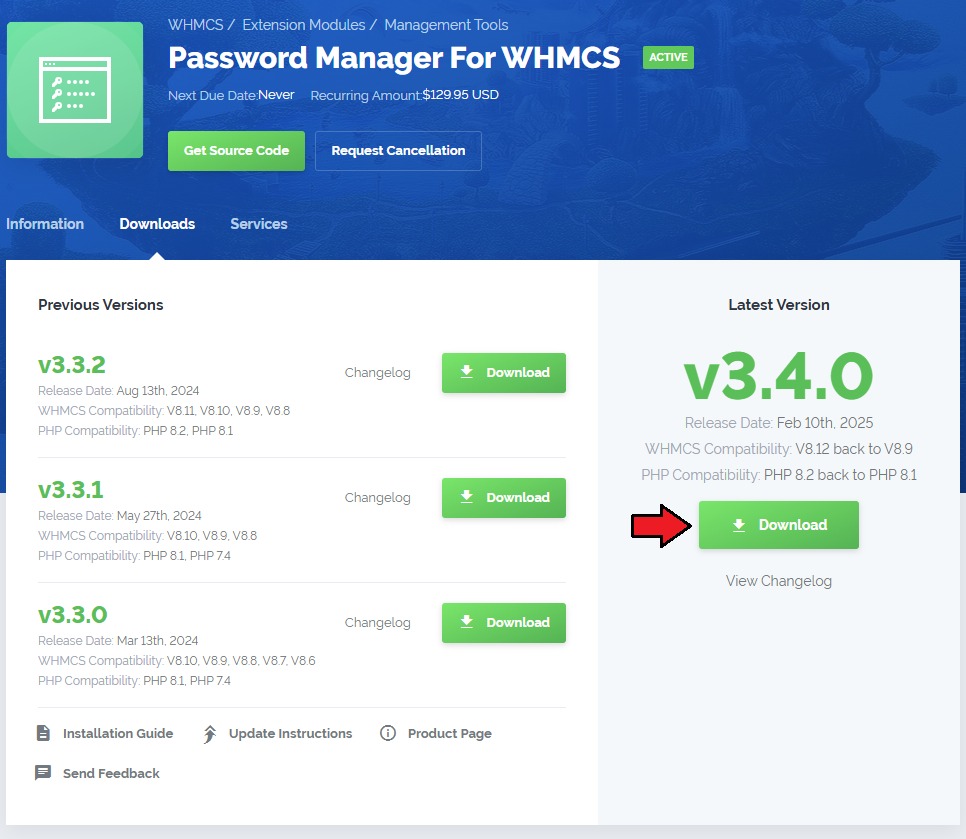
|
| 2. Upload and extract the module into the main WHMCS directory. Files in your WHMCS directory should look like these. |

|
| 3. When you install Password Manager for the first time you have to rename 'license_RENAME.php' file. File is located in 'modules/addons/PasswordManager/license_RENAME.php'. Rename it from 'license_RENAME.php' to 'license.php'. |
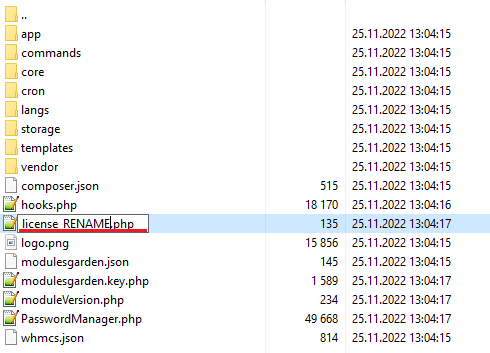
|
| 4. In order to configure your license key, you have to edit a previously renamed 'license.php' file. Enter your license key between quotation marks as presented on the following screen. You can find your license key in your client area → 'My Products'. |

|
| 5. Now you have to activate the module in your WHMCS system. Log in to your WHMCS admin area. Go to 'Setup' → 'Addon Modules'. |

|
| 6. In the next step you need to permit access to the module. To do so, click on 'Configure' button, select administrator groups which should have access to this addon and press 'Save Changes'. |
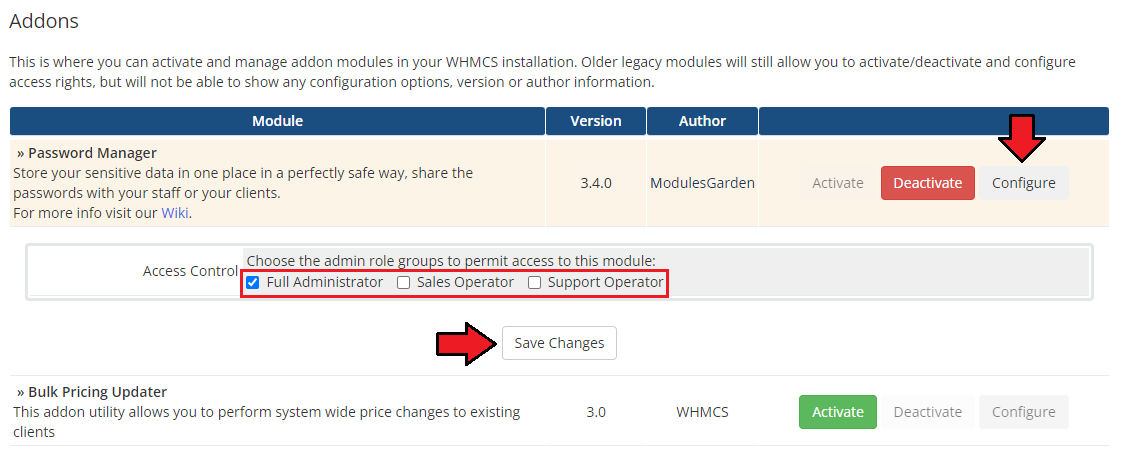
|
| 7. You have just successfully installed Password Manager For WHMCS! You can access your module under 'Addons' → 'Password Manager'. |
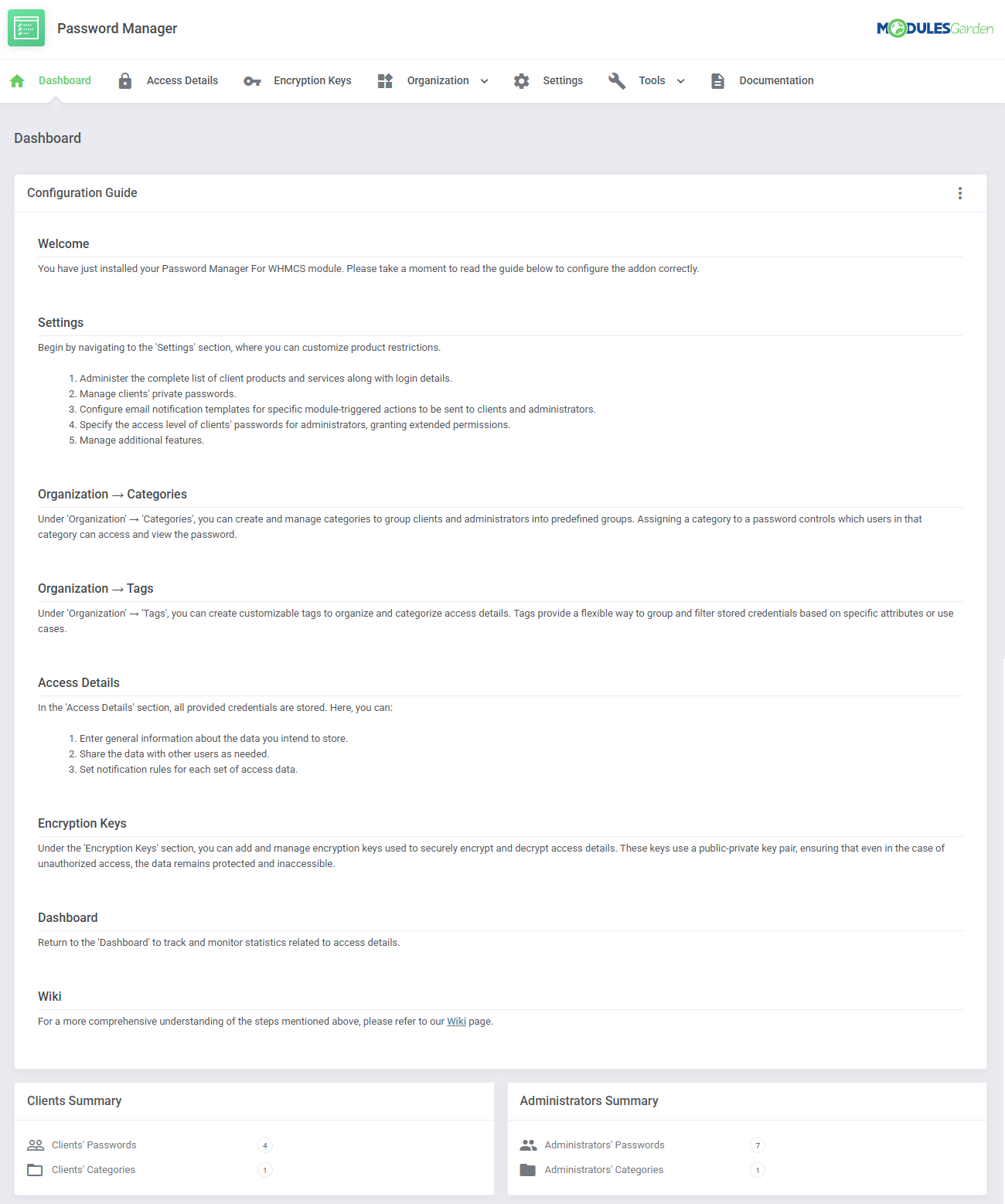
|
Configuration and Management
| Password Manager For WHMCS allows to share passwords in your WHMCS. In this short guide we will present you the possibilities of our module. |
Configuration
| Before you start your work with our Password Manager For WHCMS, please move to 'Settings' tab, where you will configure access restrictions to products passwords, define email notifications and manage security settings. |
Client Product Password
| First of all, decide whether you wish to allow to display a full list of client's products and services login details by selecting option: 'Client Product Password'. If enabled, access details to client's products and services will be displayed in the client area → 'Password Manager'. 'Exclude Client Groups' - enter any client group name to disable product's access details from being displayed for clients in these groups. |
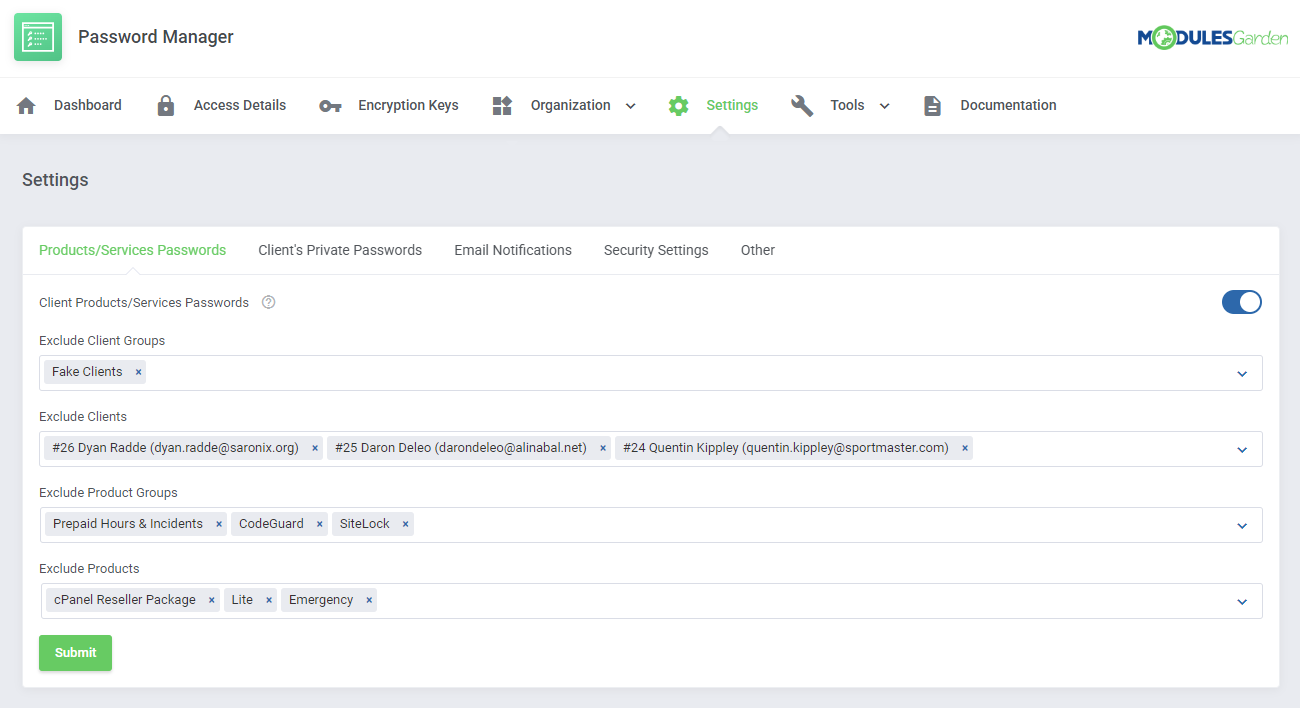
|
Client Private Passwords
| The next section is dedicated to the management of private passwords of clients. If you wish to allow your clients to manage their personal access details them select 'Client Private Passwords' option and then move to specific configuration: 1. 'Exclude Client Groups' - disable private access details management for selected here client groups. |
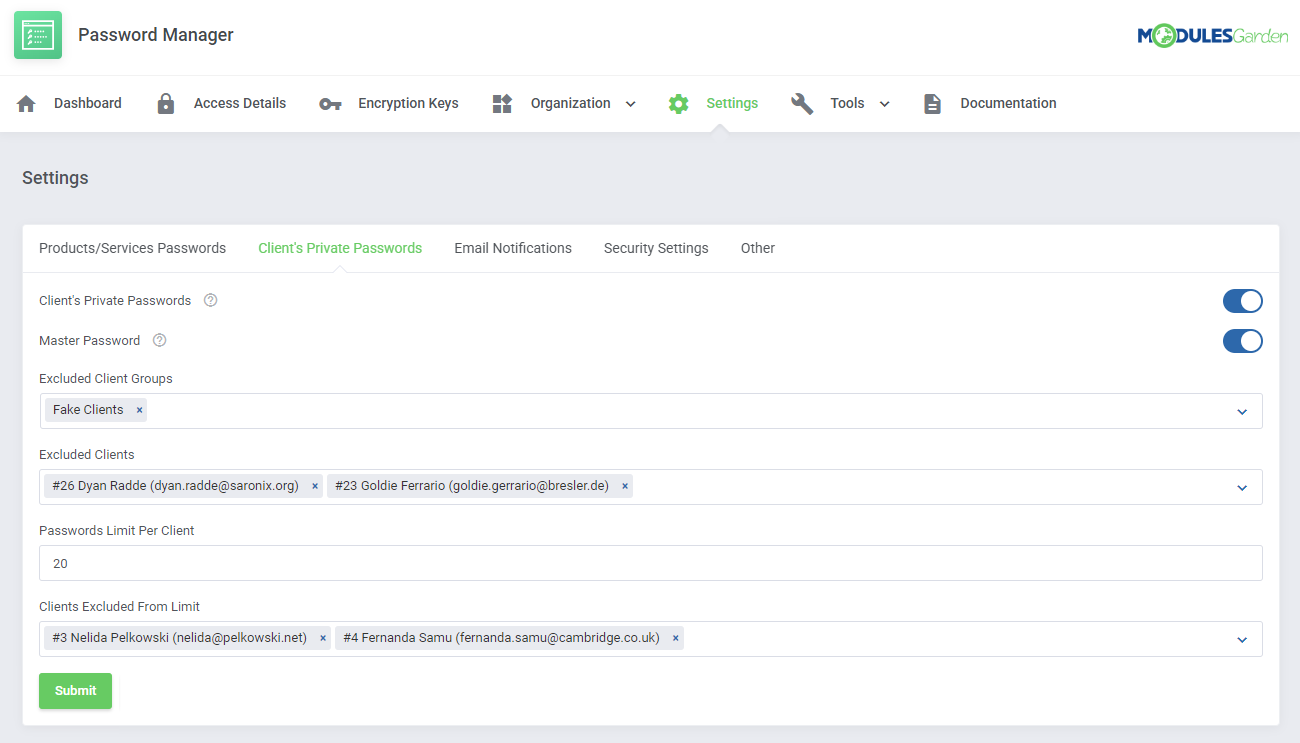
|
Email Notifications
| This section allows you to define email notification templates that will be sent by the module on specific actions to clients and administrators. 1. 'Password Change Reminder' - select an email template that will be used to remind clients or admins about the need to change the password. |
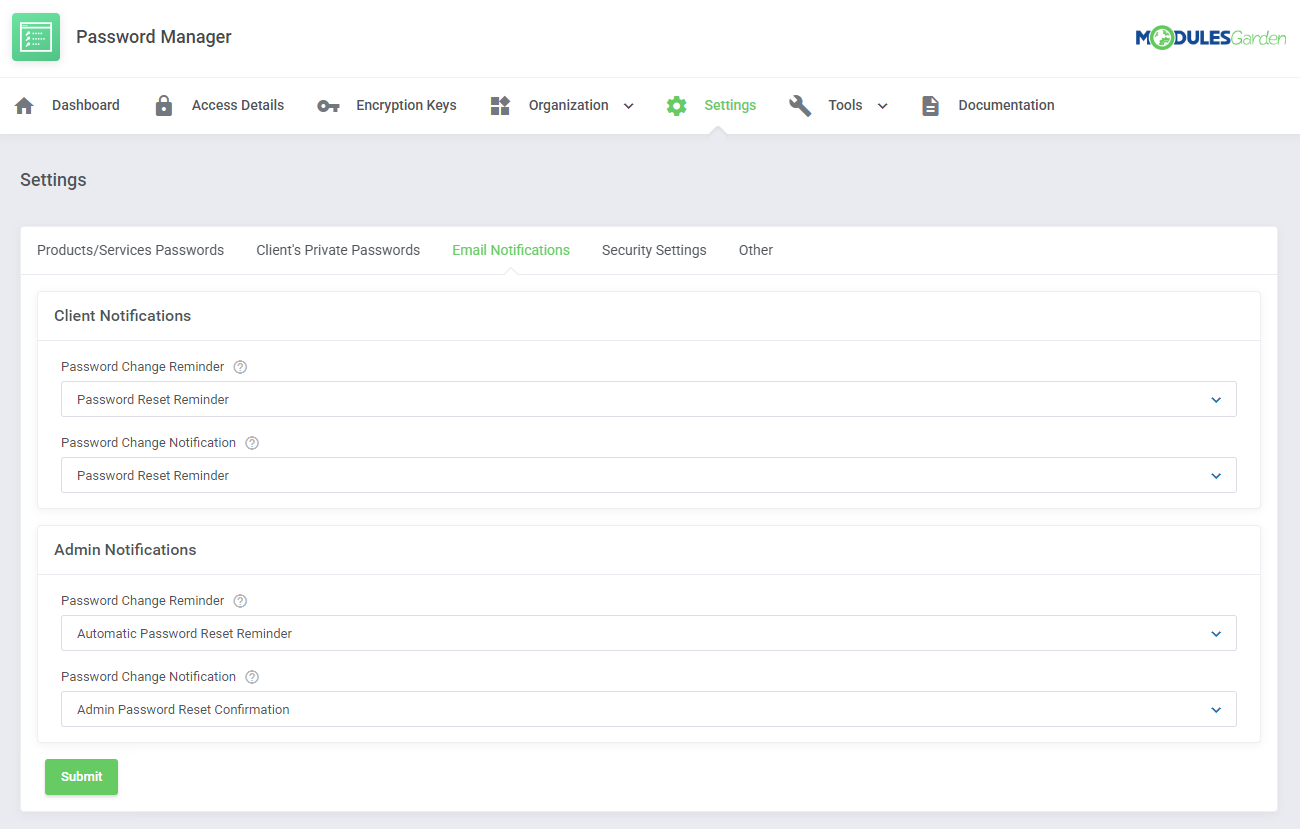
|
Security Settings
| Under 'Security Settings' tab, you have to define the level of access to clients' passwords for administrators and grant them extended permissions. You may grant your admins:
You may also select here administrators group which will be granted 'Extended Permissions'. |
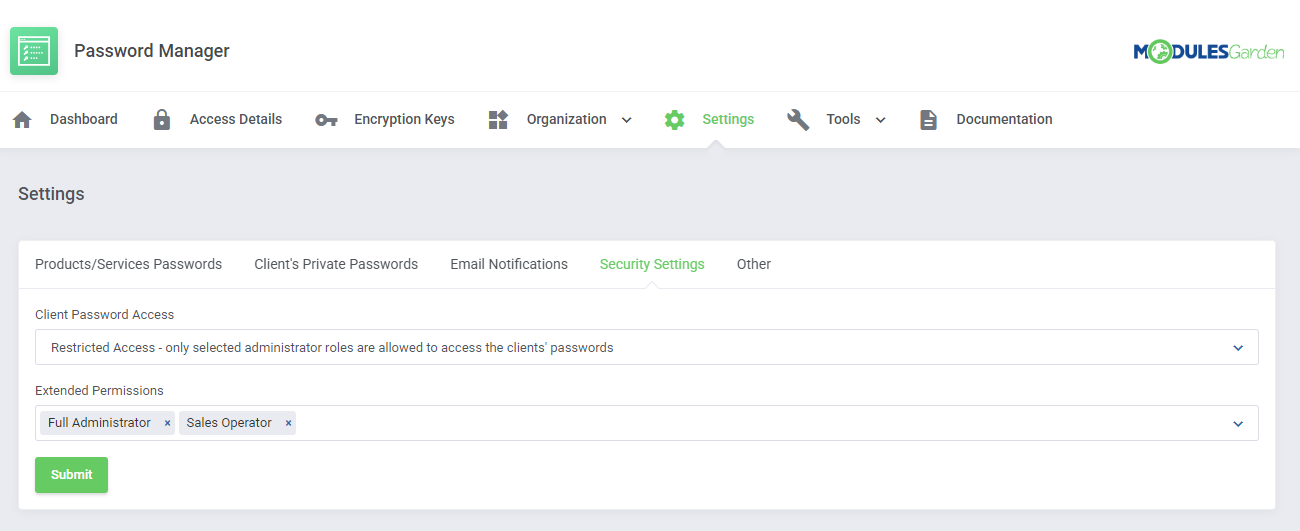
|
Other
| In the very last section you may manage additional options that 'Password Manager For WHMCS ' has to offer. 1. Select to enable access to 'Password Manager' for your clients in their client area |
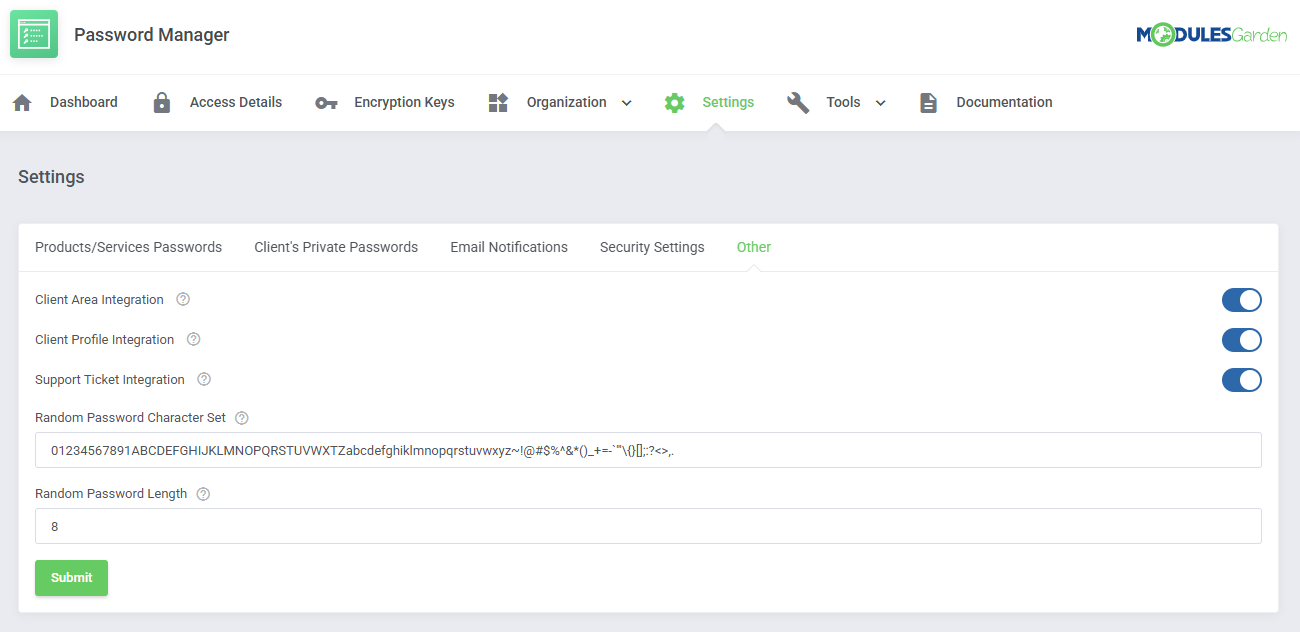
|
Categories
| Categories allow you to prepare predefined sets of clients and administrators. Through assigning a category to a password, clients and administrators from that category are granted with permission to view the password. |
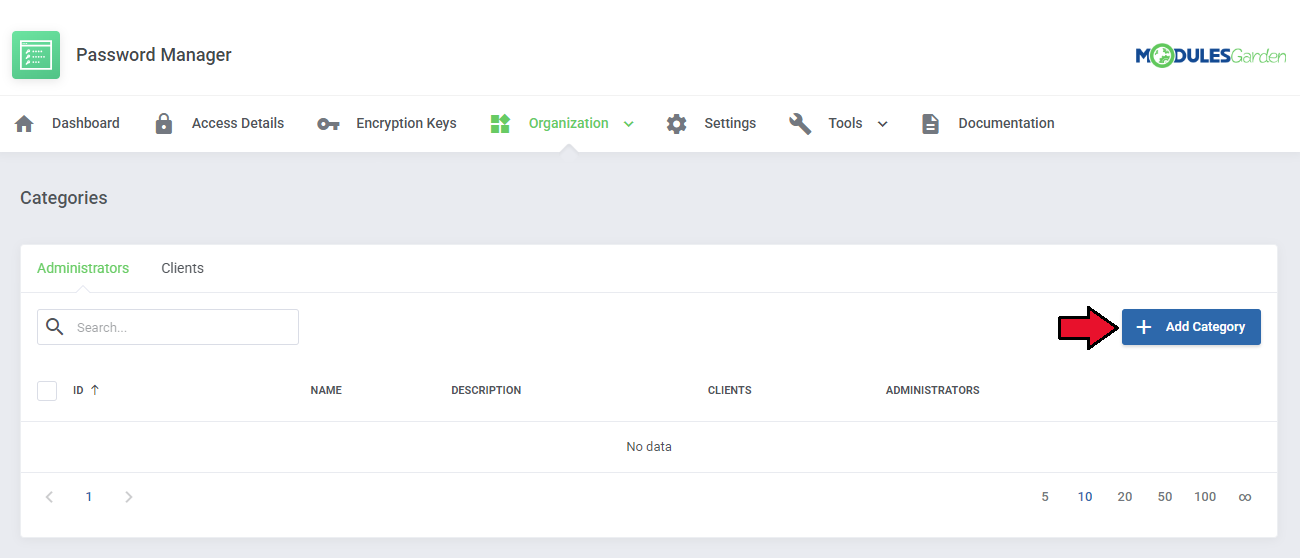
|
| Now, fill out the form with category name and description. Assign desired clients and admins to the category and press 'Add'. |
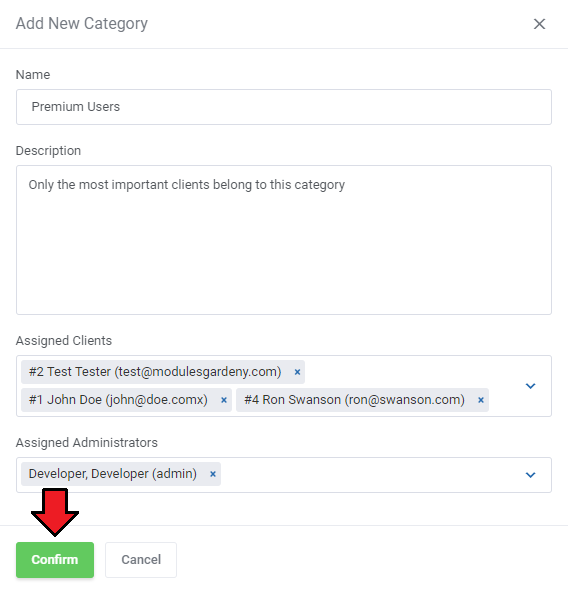
|
| A list of admin categories with any details such as number of clients in it and admins allowed to access the details is now visible. You may always edit the category or delete if needed. Use action buttons to do so. |
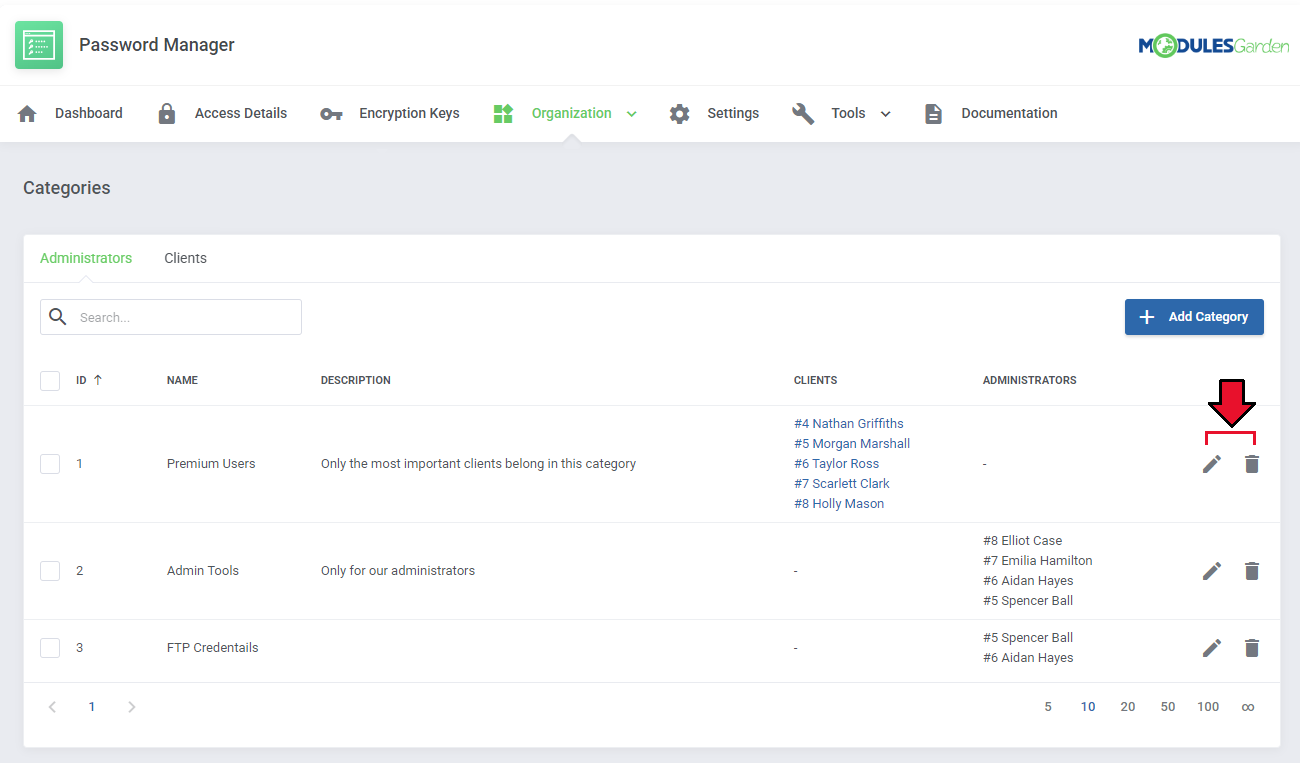
|
Access Details
| 'Access Details' section includes a list of provided access details. Here you can create new access details and decide who can view them. Press 'Add New' to begin. |
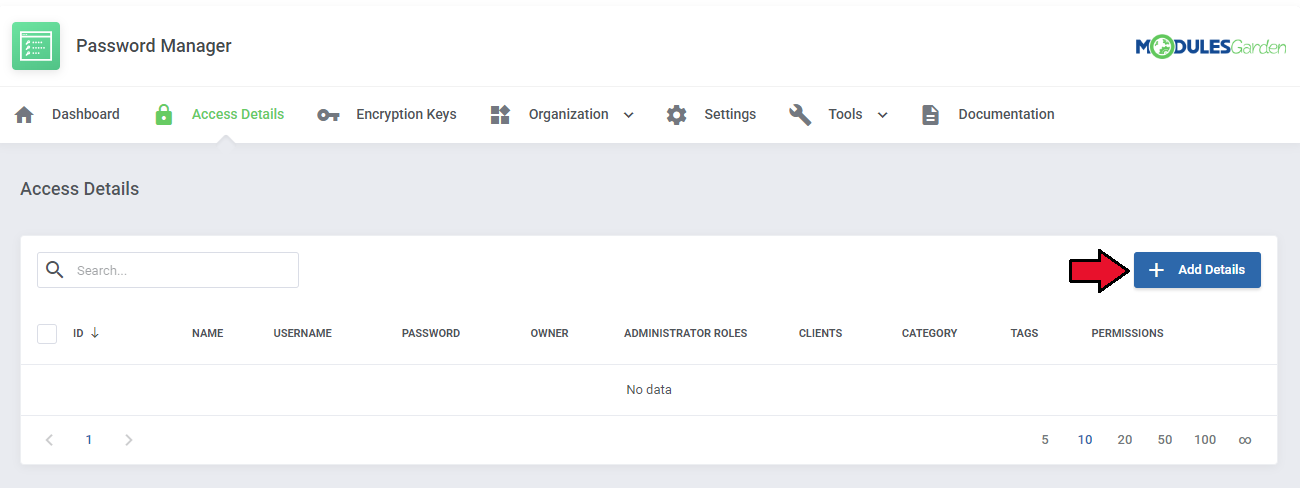
|
| Fill in 'Name', enter access details into 'Username' and 'Password'. You can also make your logging in easier through entering website URL and website log in URL consecutively into 'Website URL' and 'Log In URL'. |
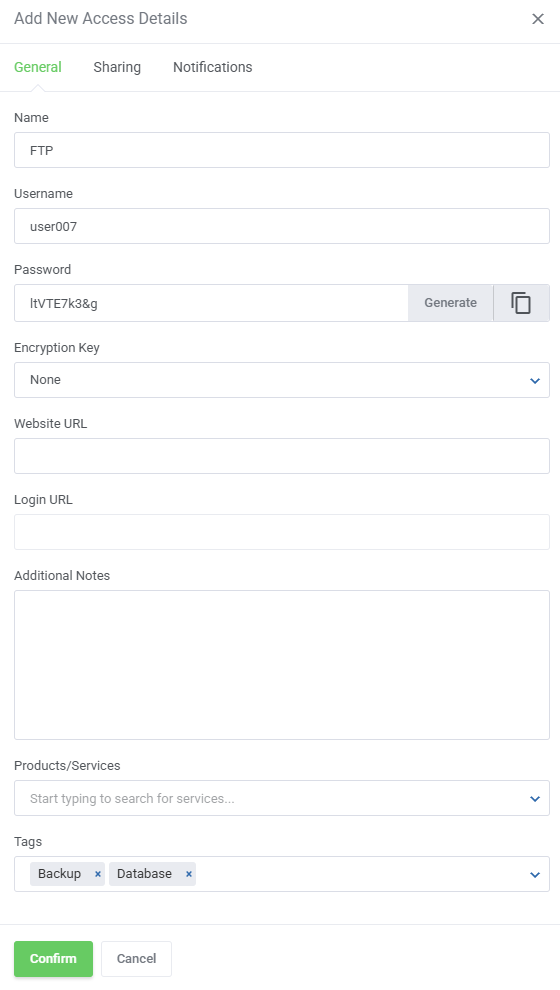
|
| In this section choose 'Category' and select 'Admins', 'Admin Groups' and 'Clients' who should have access to this details. Note: There is disjunction relation between 'Admins' and 'Admin Roles'. |
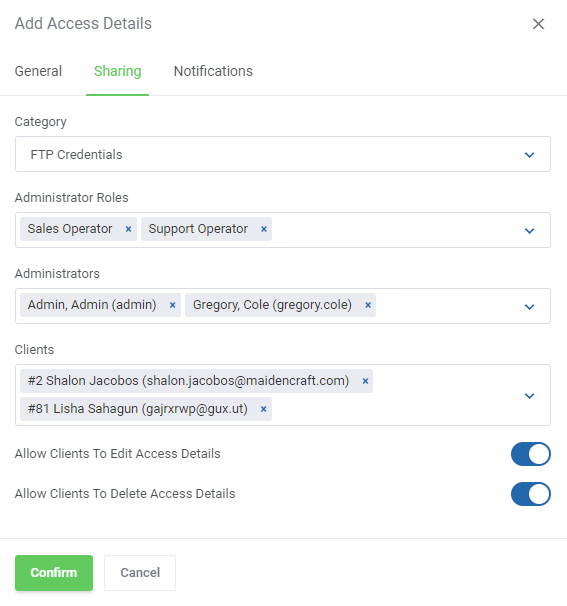
|
| Finally, you can set up notifications rules. 'Send Password Change Notification' - message is sent upon password being changed. |
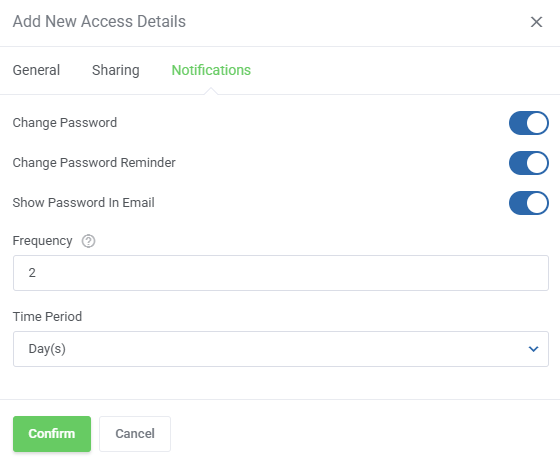
|
Access Details List
| On the list of access details you will see some basic info, such as ID and name, username and password with the possibility to view the password. |
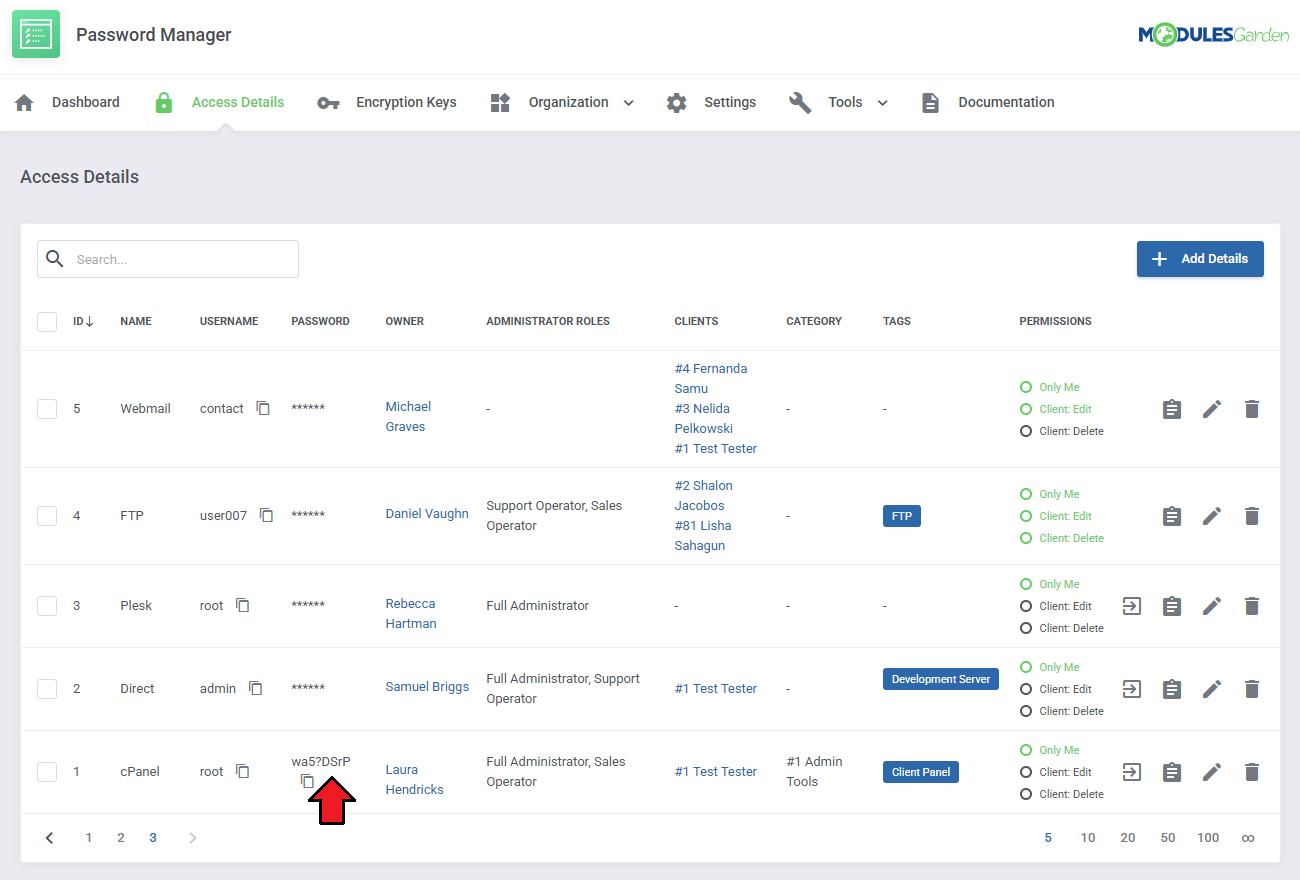
|
| There is also information on the access details owner and admin groups allowed, number of clients allowed and category assigned (press the category to see who exactly is in it). Finally you, check set up edit permissions. |
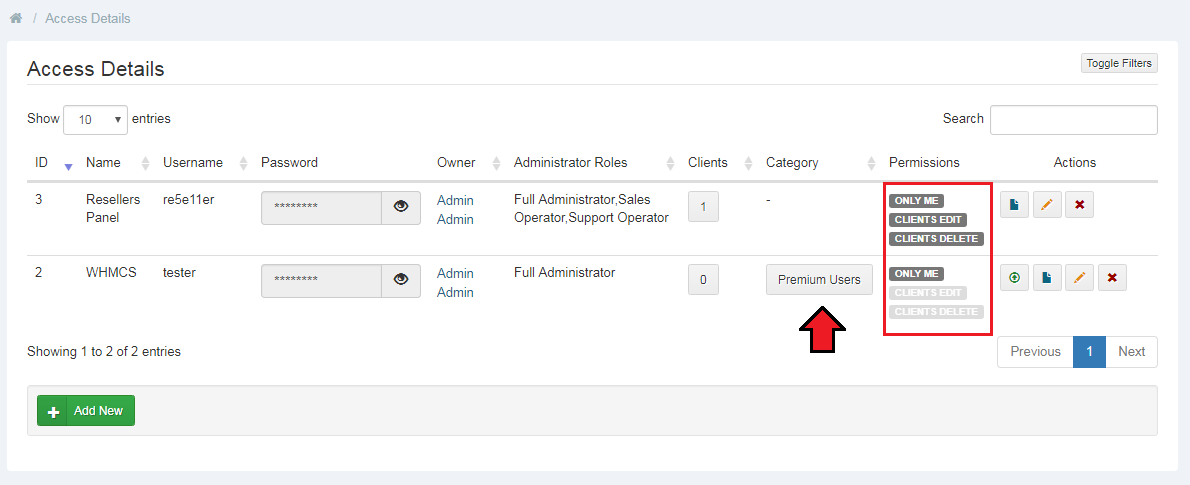
|
| Use action buttons to manage the entered access details.
1. Log into your website (if URL has been provided) |
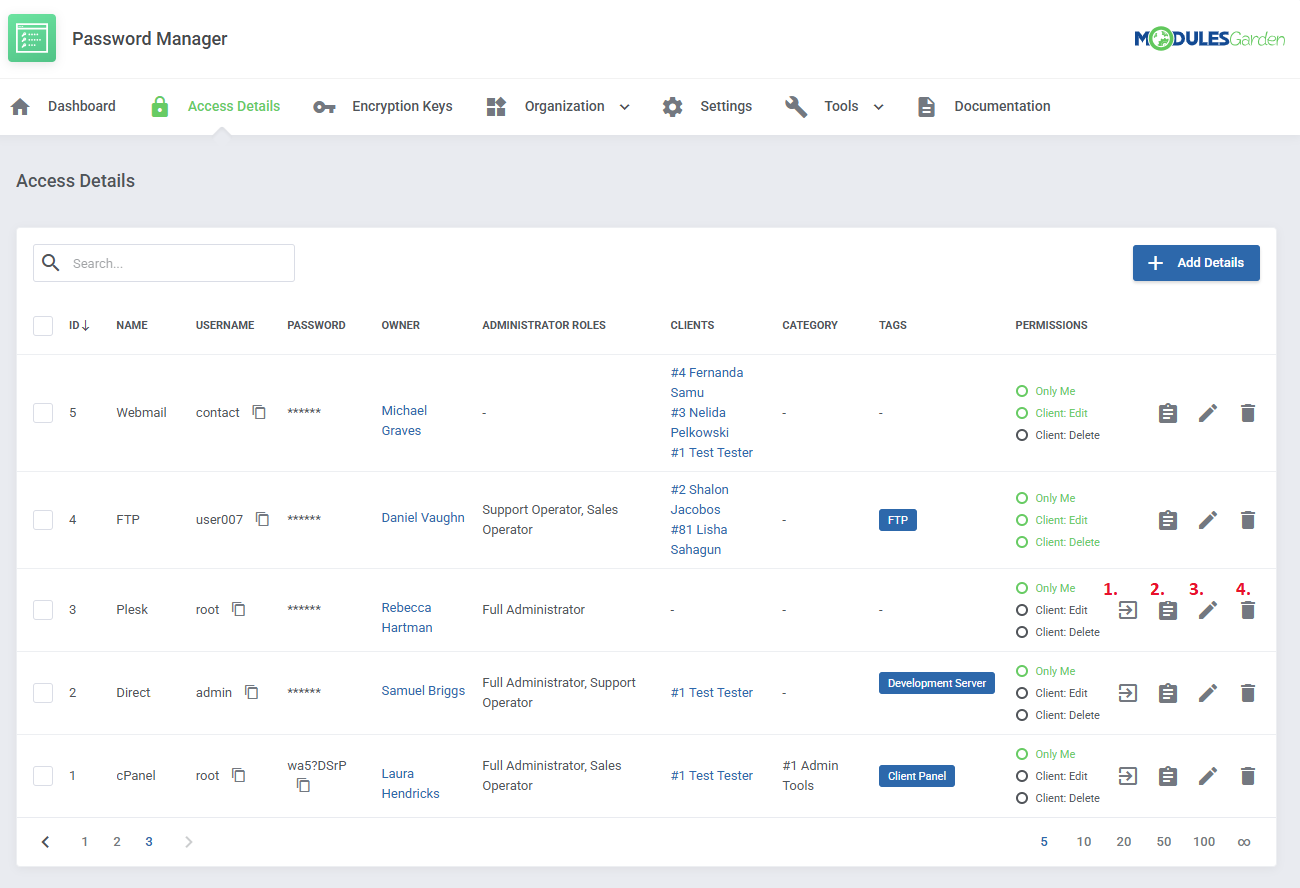
|
Dashboard
| On 'Dashboard' there is available a short summary on the Clients' and Administrators' access details and categories. |
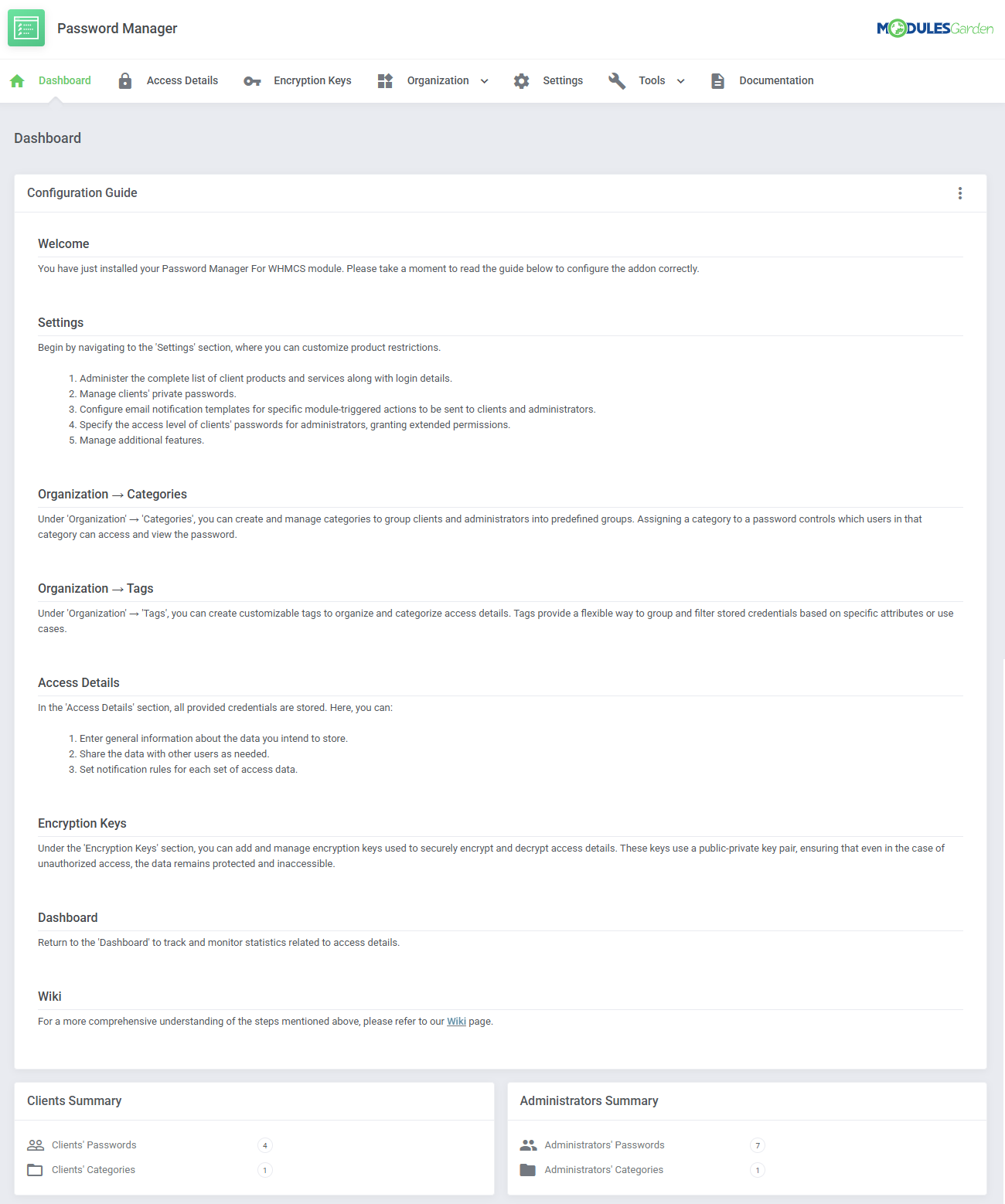
|
| The last tab in the addon 'Documentation', when pressed, redirect you to this very site. |
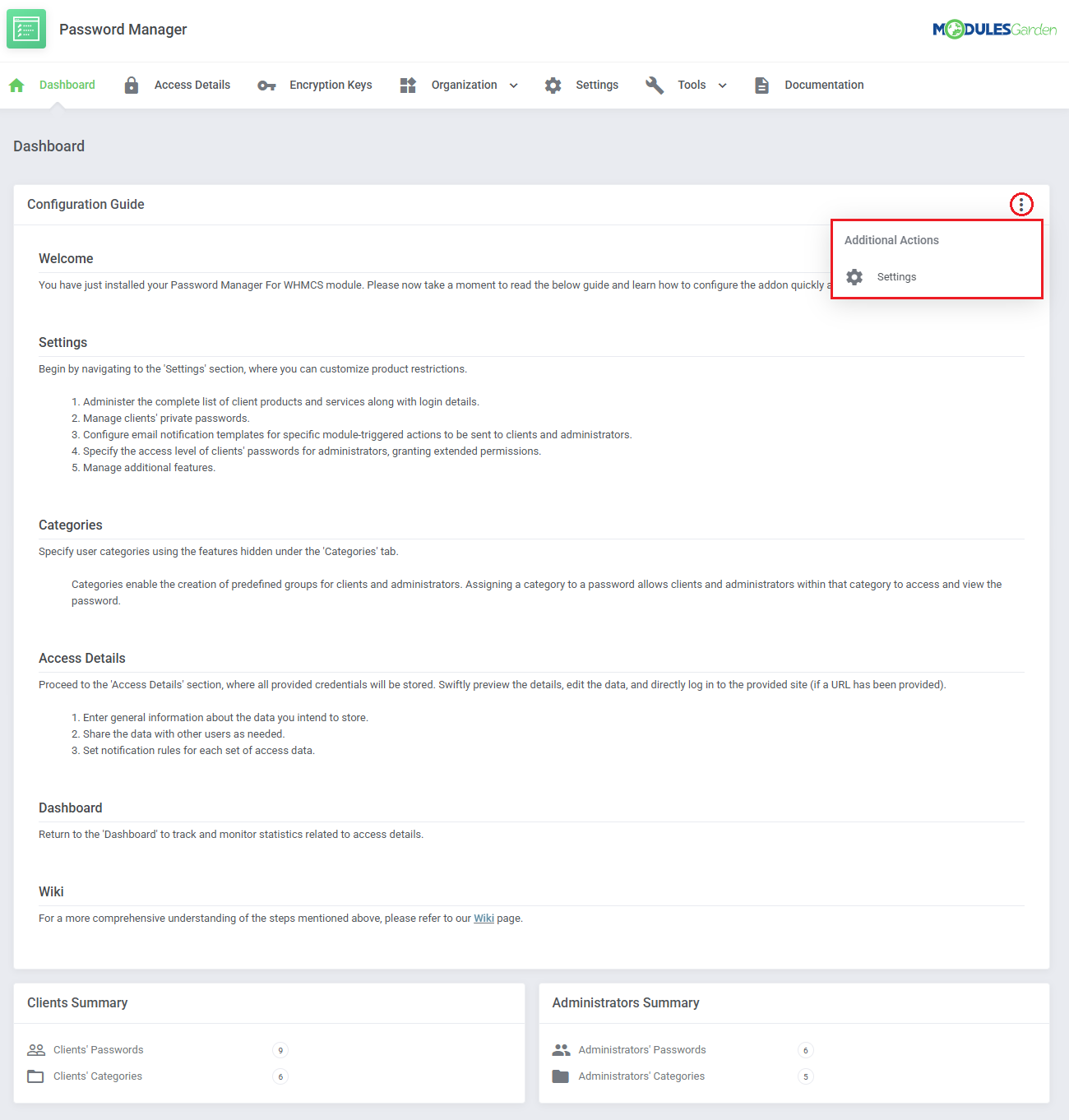
|
Admin Area Integration
| Our module integrates with your admin area as well as client area. Passwords of any client can be viewed in summary page as it is shown below, but only if you enable this option in 'Settings' section in the addon. |
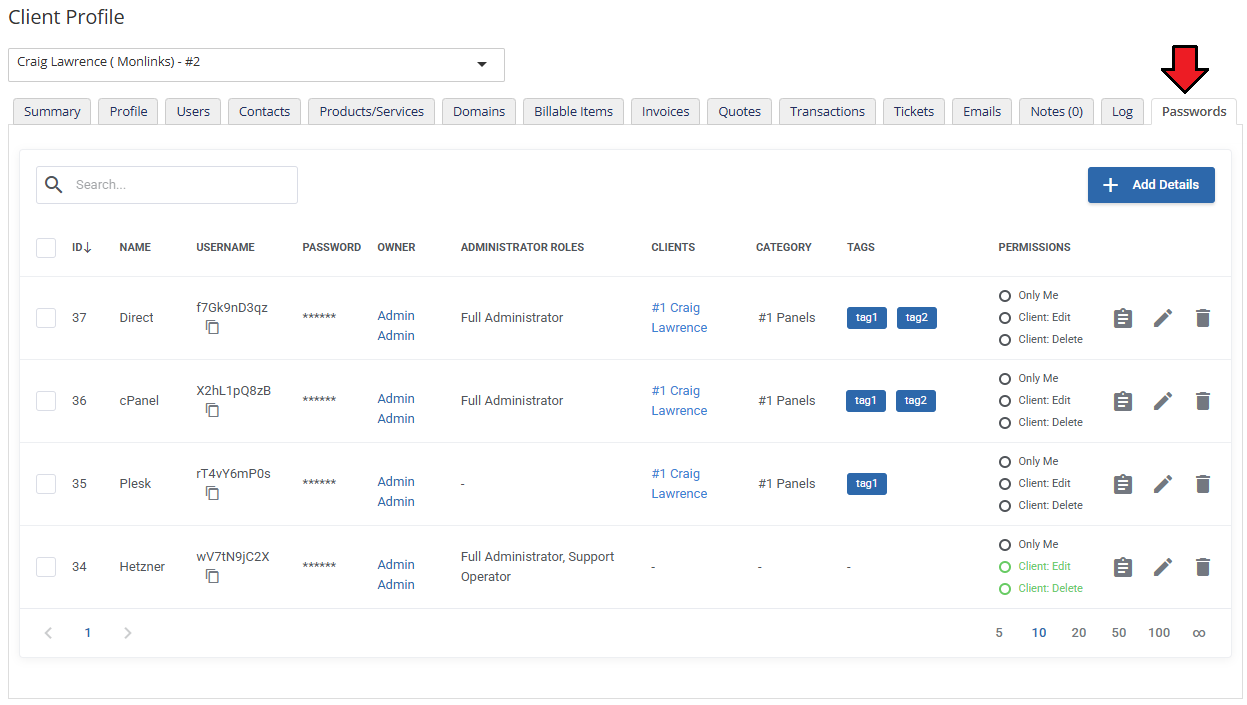
|
| Your support operators are also able to access clients passwords from within ticket. As you may have noticed, these places allow them not only to see passwords, but also create new ones. |
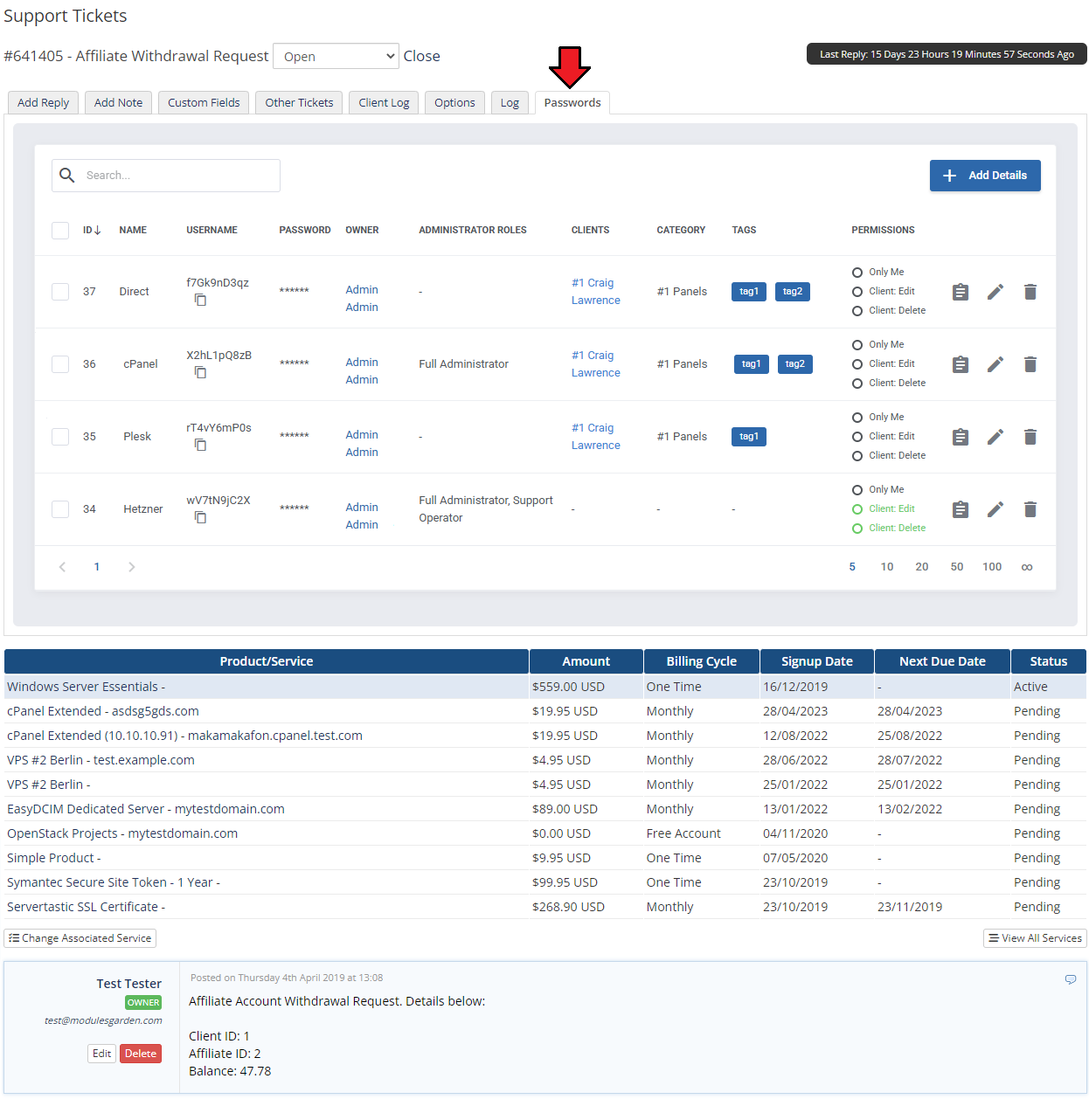
|
Client Area
| Your clients can access client area password management page through 'Password Manager' button in navigation bar. To allow integration with client area, a proper option must be enabled in 'Addon' → 'Settings' → 'Other'. |
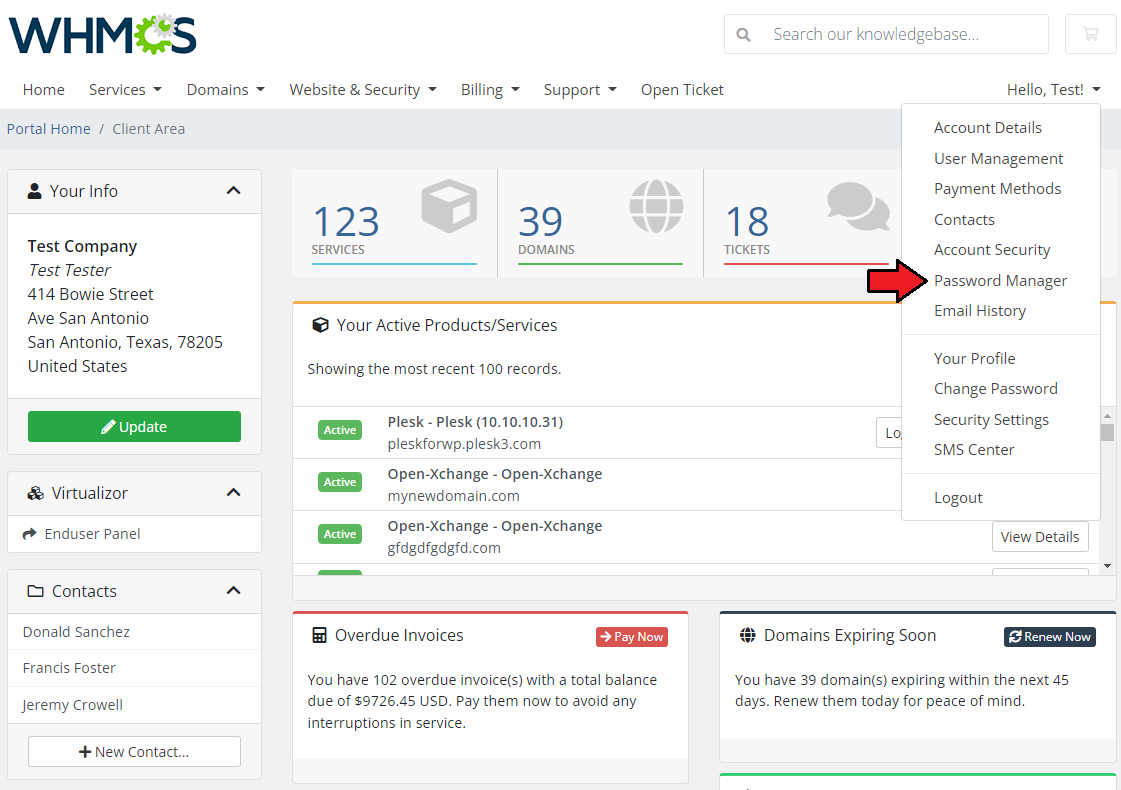
|
| In 'Password Manager', your clients can view access details depending on the settings configured by the administrator and level of access allowed for the client. Underneath you can see a client's area with full access to any option given. As you can see, there are four sections available: 'Owned Passwords', 'Shared Passwords', 'Product Passwords' and 'Categories'. |
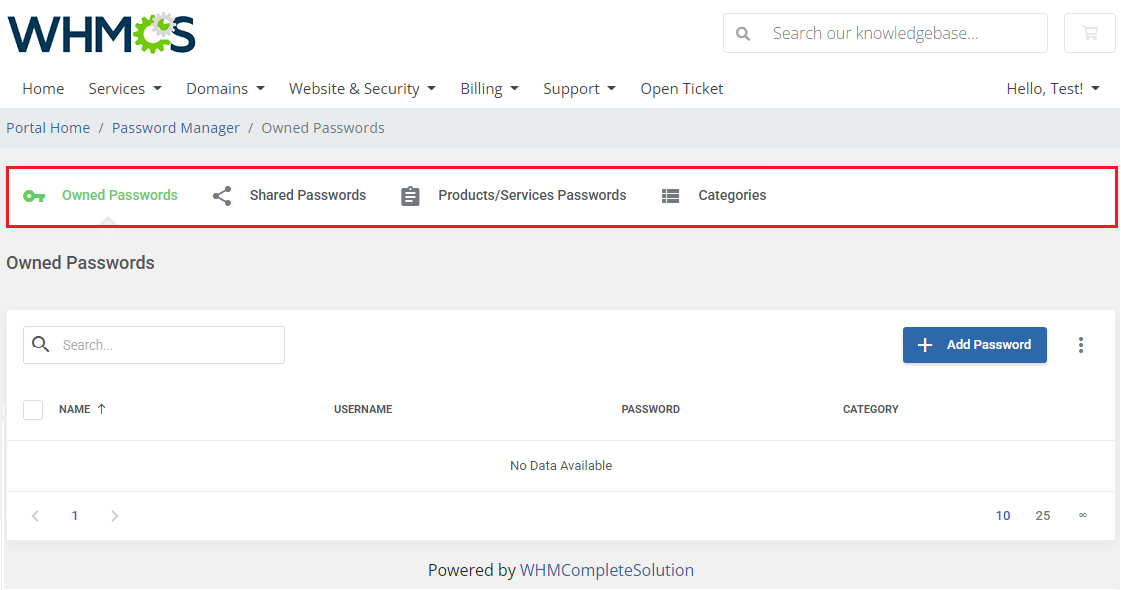
|
Owned Passwords
| If you enabled 'Client Private Passwords' your clients will be allowed to view, manage and create their own access details. |
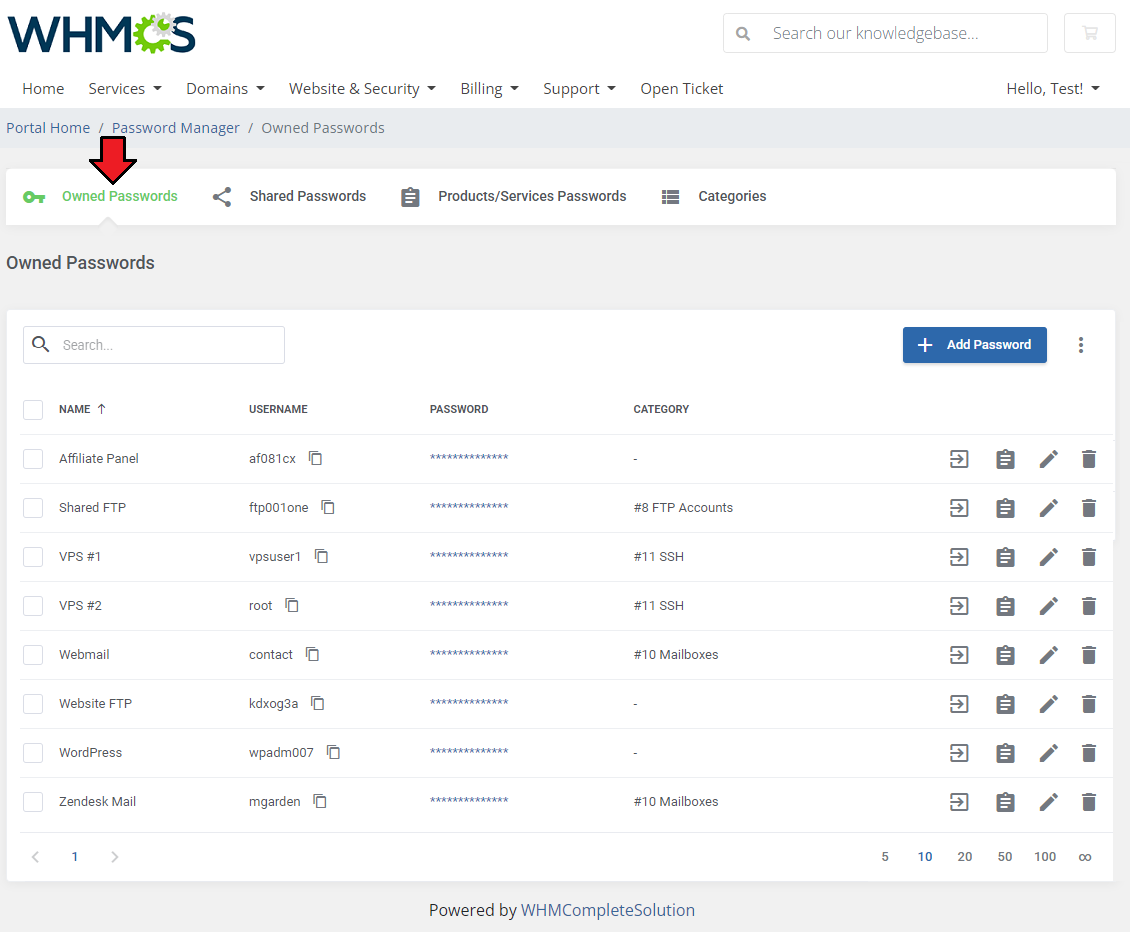
|
| Preview the password and use action buttons to manage the access details:
1. Log into URL |
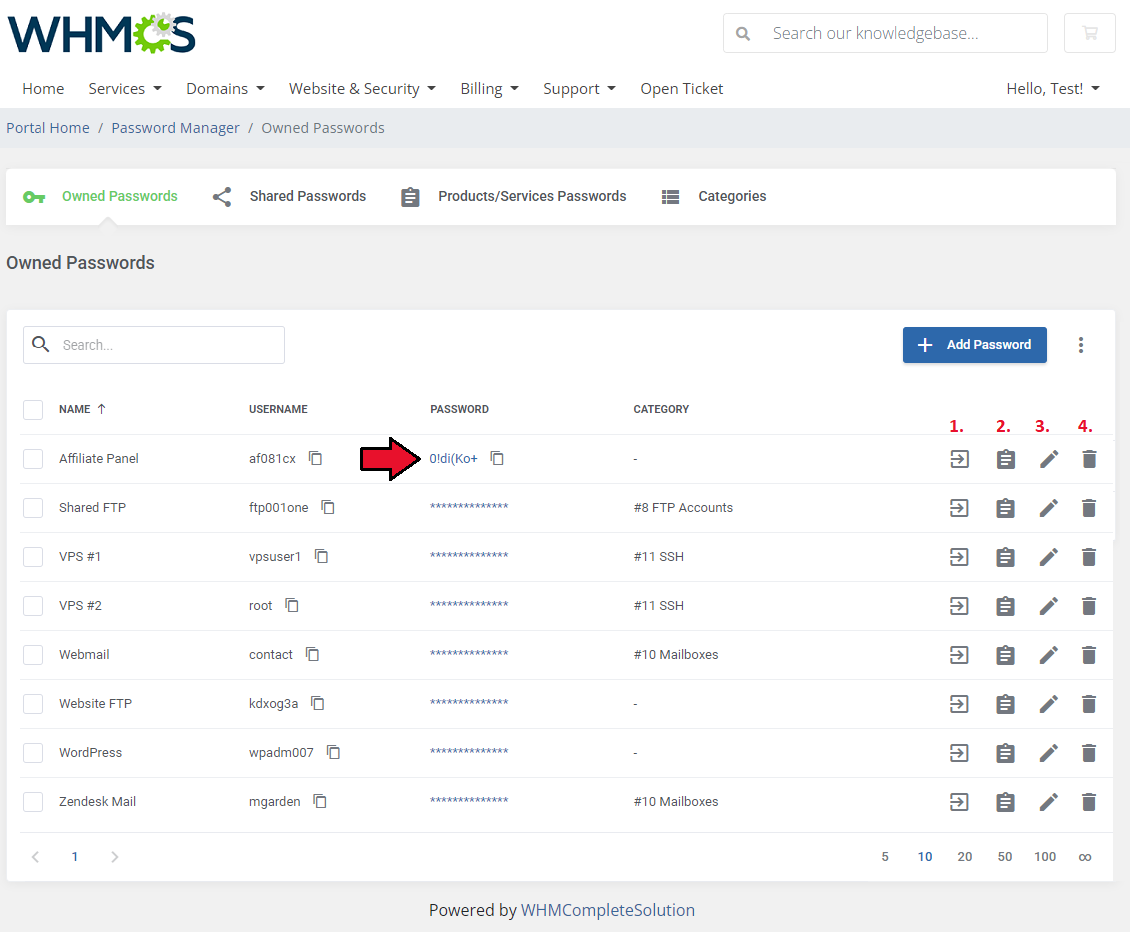
|
Add Access Details
| To create access details, press 'Add New' button as shown on the following screen. |
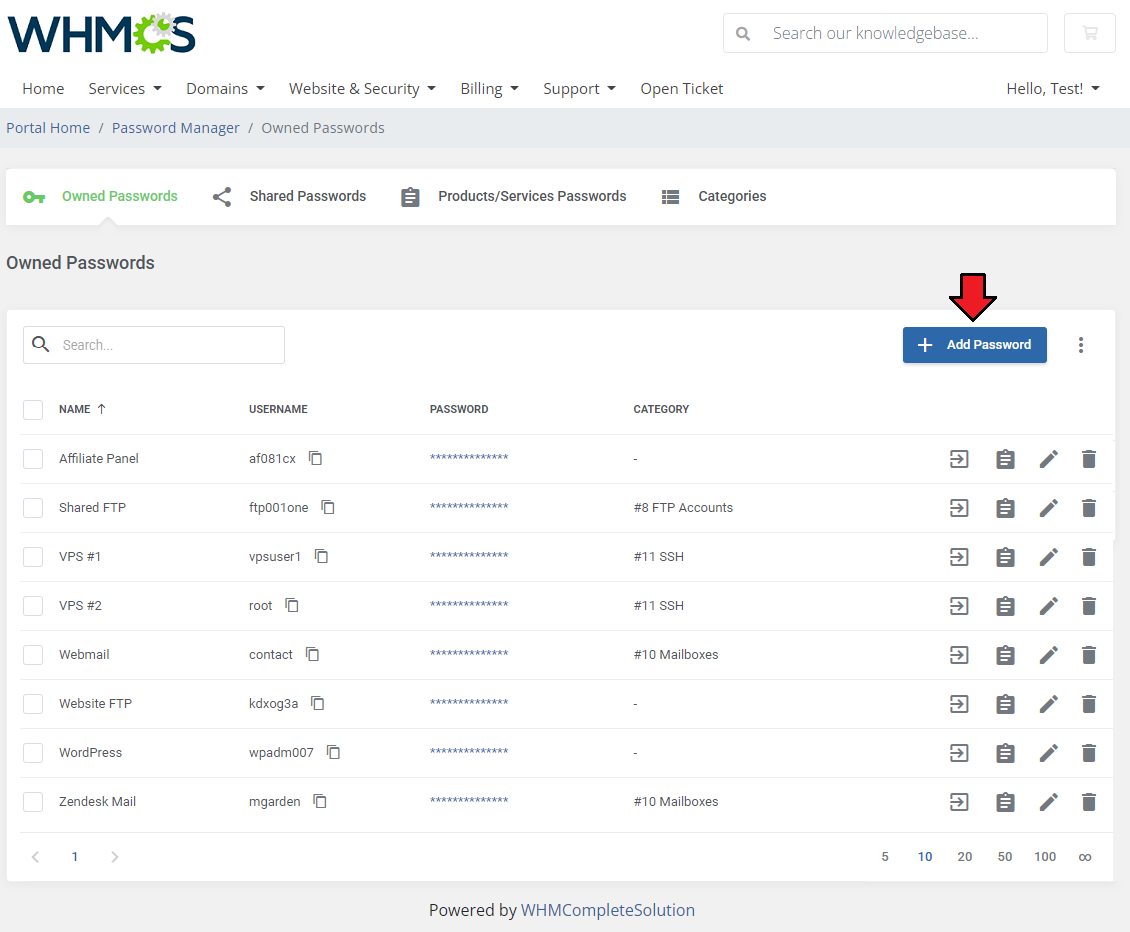
|
| Type the new password name and enter access details into 'Username' and 'Password'. Optionally, provide 'Website URL' and 'Log In' URL to be allowed to log into your site directly from 'Password Manager' page. |
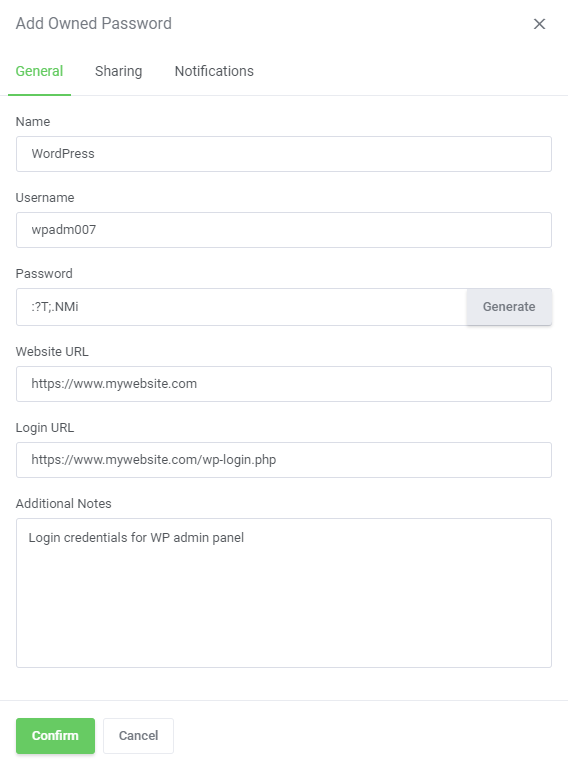
|
| You may now move to 'Sharing' section. There, you can decide which category the new access details will be assigned to. Choose one from dropdown menu or select 'Unassign' to leave it without any category. Depending on the category you select, the access details will be available for those specified in its configuration. |
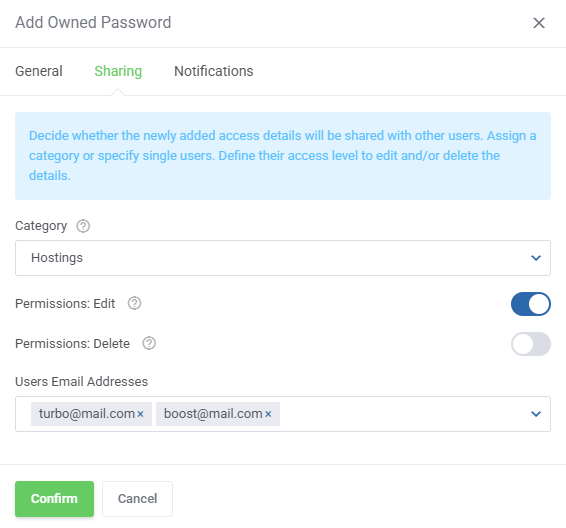
|
| Finally, in ' Notifications' section, set up conditions of delivering password notifications. Enable this option if you need it and define when the reminders should be sent. You can also define whether you wish to receive the new password in the message. Do not forget to press 'Add' to finish. |
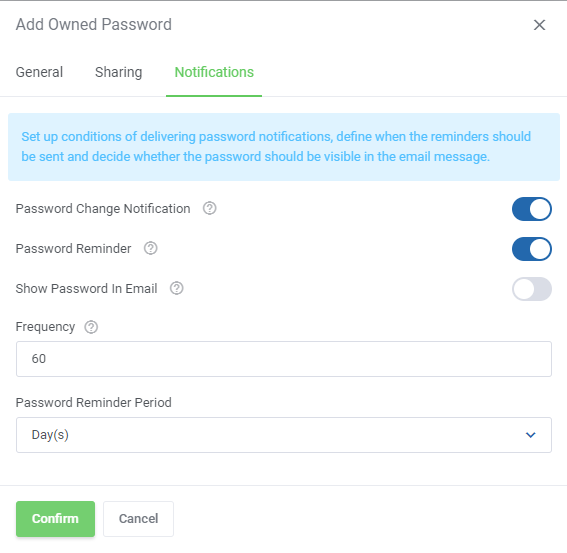
|
| Under 'Shared Passwords' your clients can view and manage access details that admins shared with them, gave permission to view. |
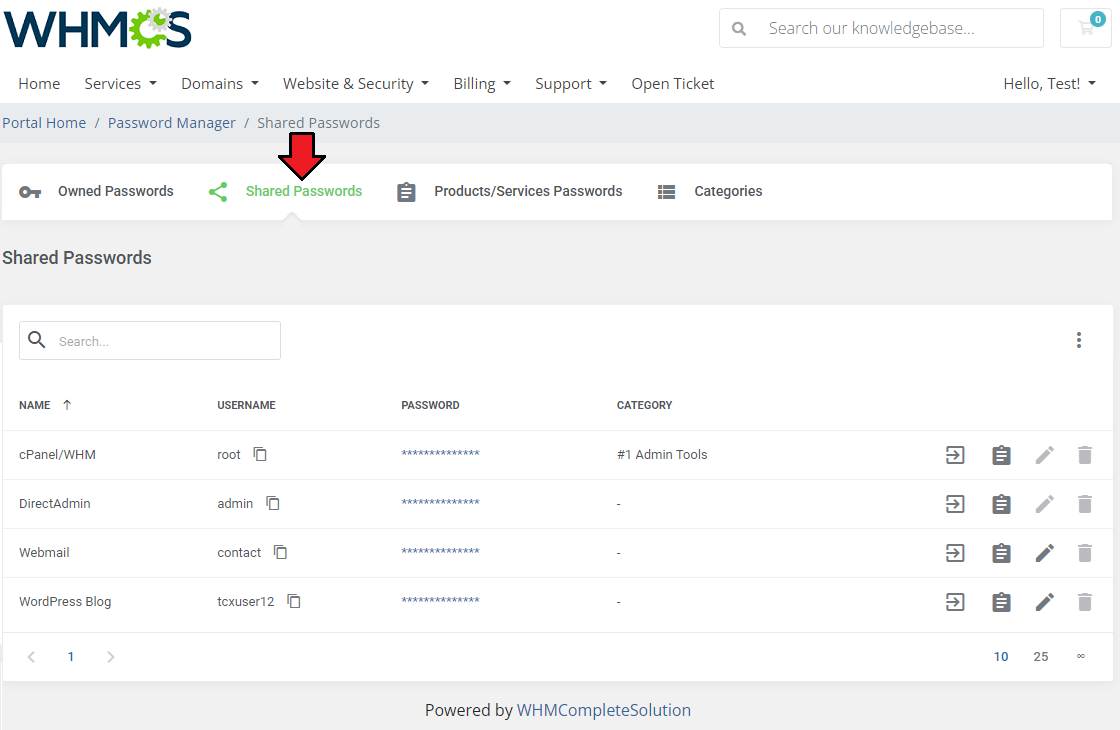
|
| Preview the password and use action buttons to manage the access details:
1. Log into URL if it has been provided |
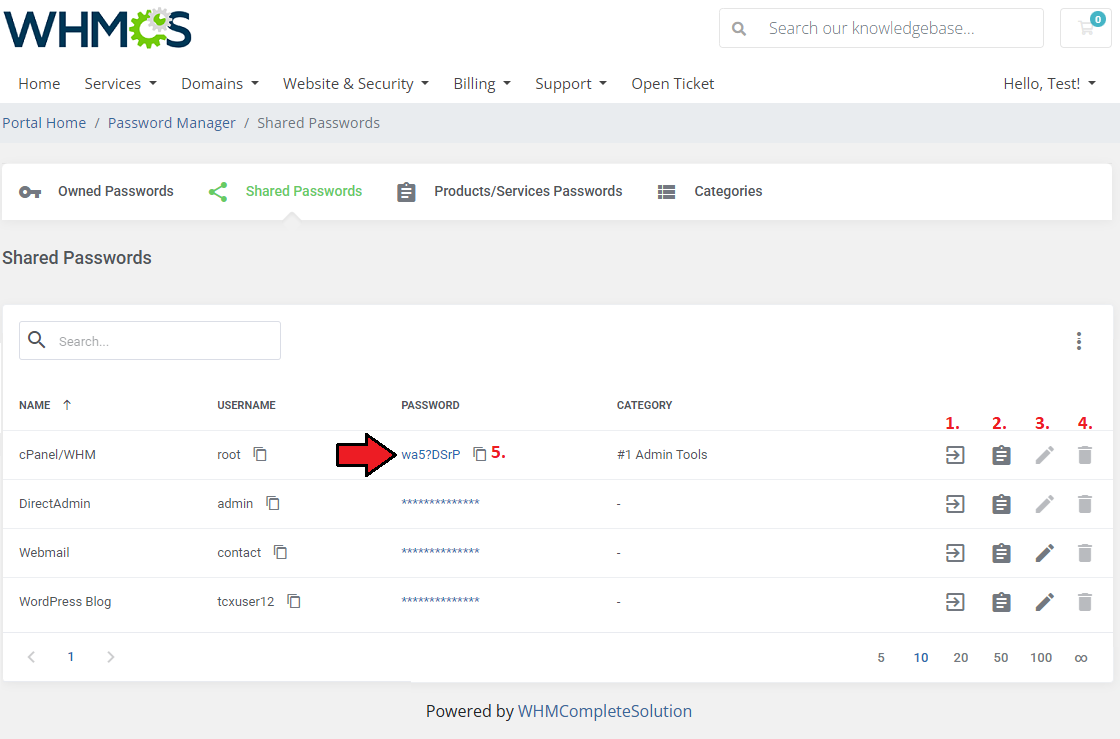
|
Product Passwords
| 'Product Passwords' section includes any access details on your client's products that they own. Remember that as administration you must enable this option in the 'Addon' → 'Settings'→ 'Client Product Password'. |
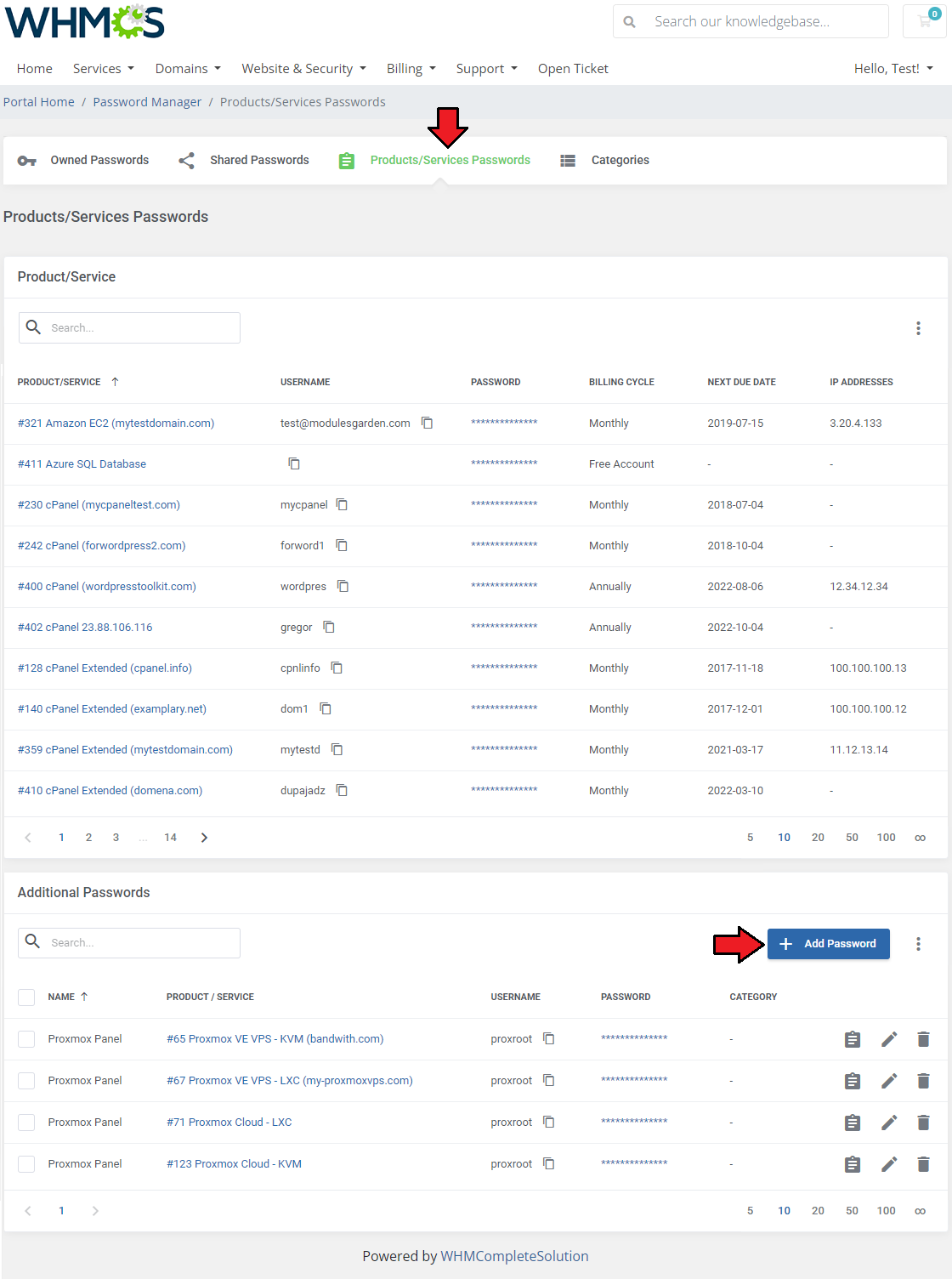
|
Categories
| Move to 'Categories' tab. There is a list of created by the client categories. To create a new one, press 'Add Category' button. |
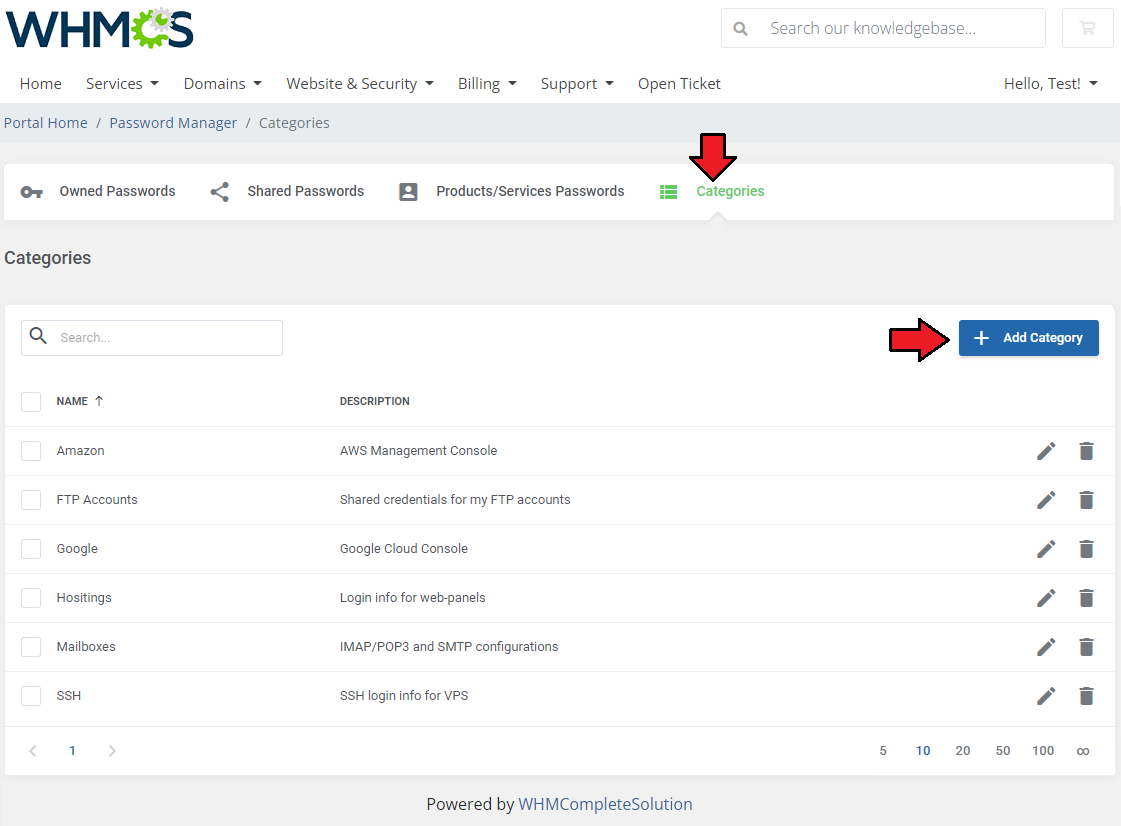
|
| Fill in category name and description and press 'Add'. Created category can be seen by this client as well as administrators in the admin area. |
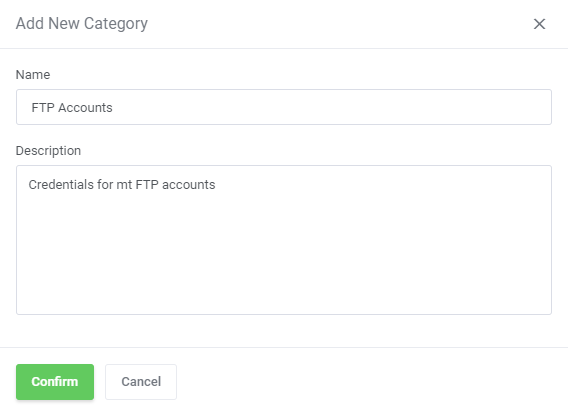
|
| Clients may edit their categories, delete and add new ones any time they wish. |
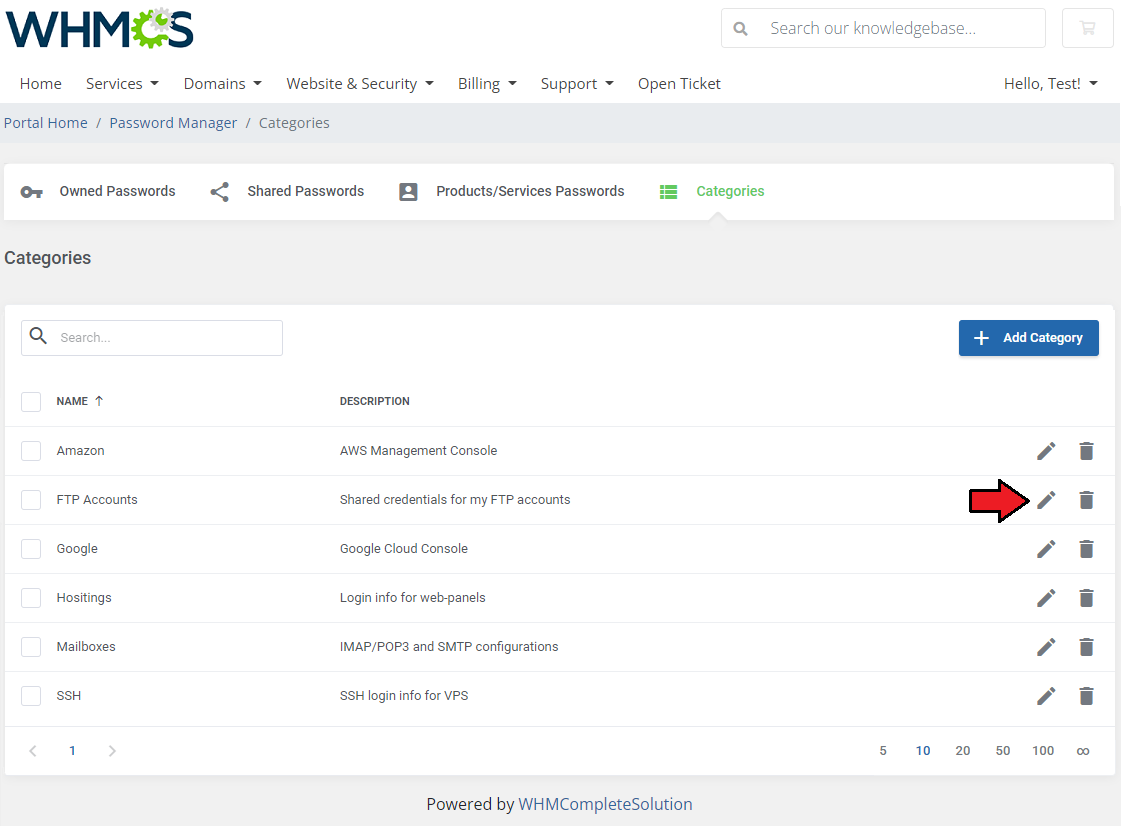
|
| Any categories created by clients will be automatically visible for admins in the addon where you can manage them. |
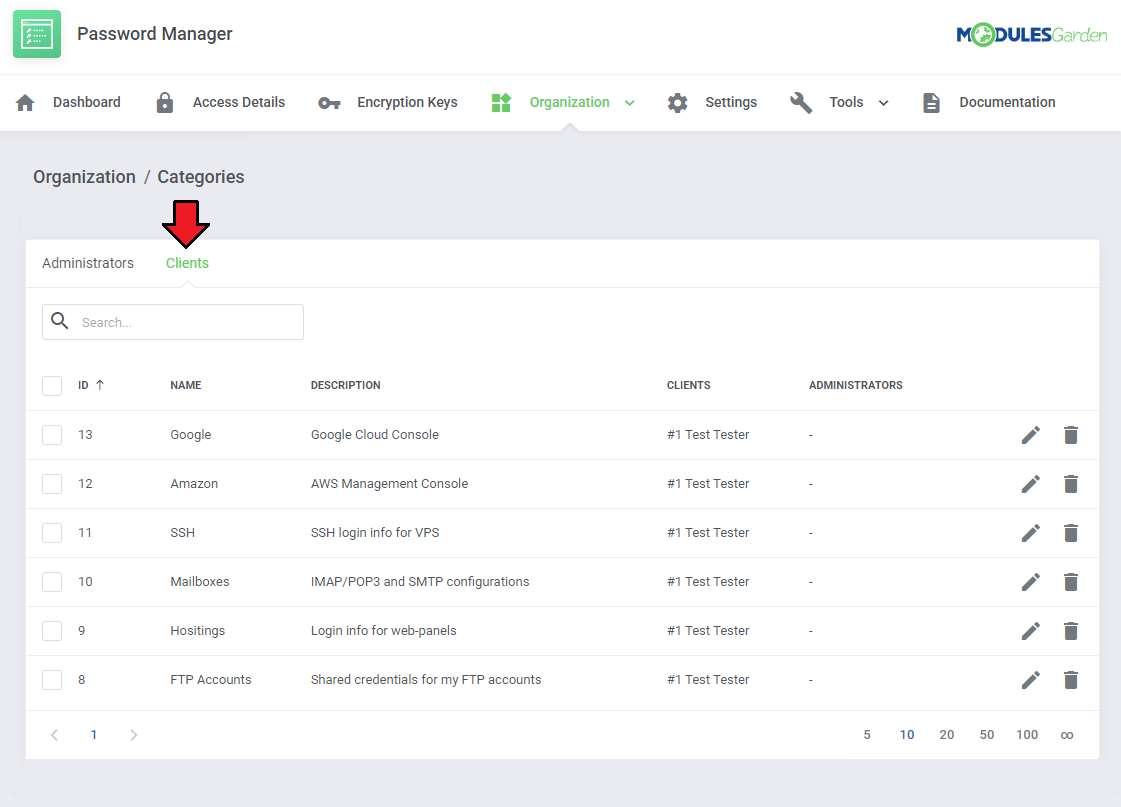
|
Tips
1. Any additional options under 'Addons' → 'Passwords Manager' → 'Settings' → 'Other' are by default enabled on the module activation.
|
Common Problems
| 1. When you have problems with connection, check whether your SELinux or firewall does not block ports. |